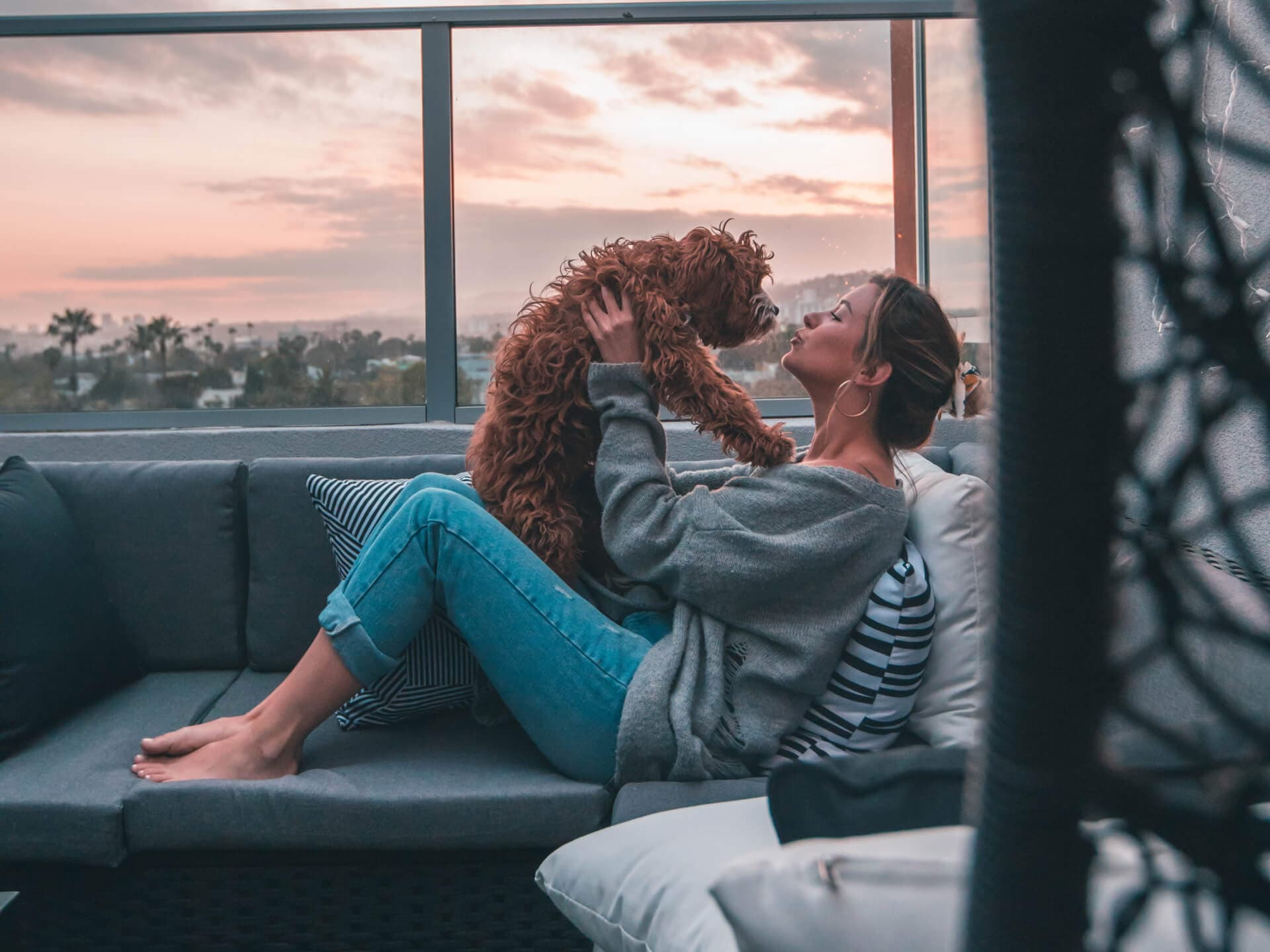
A home for your dog’s daily life
Harper
Harper was a startup I co-founded to be a system-of-record for dog owners like me. It was iPhone App of the Day and invited into Purina’s Pet Care Innovation Network.
Origin
It started with a question I just couldn’t shake
I didn’t grow up with dogs. When my wife and I brought Fitzgerald home as a puppy, it was all new to me. I went looking for help.
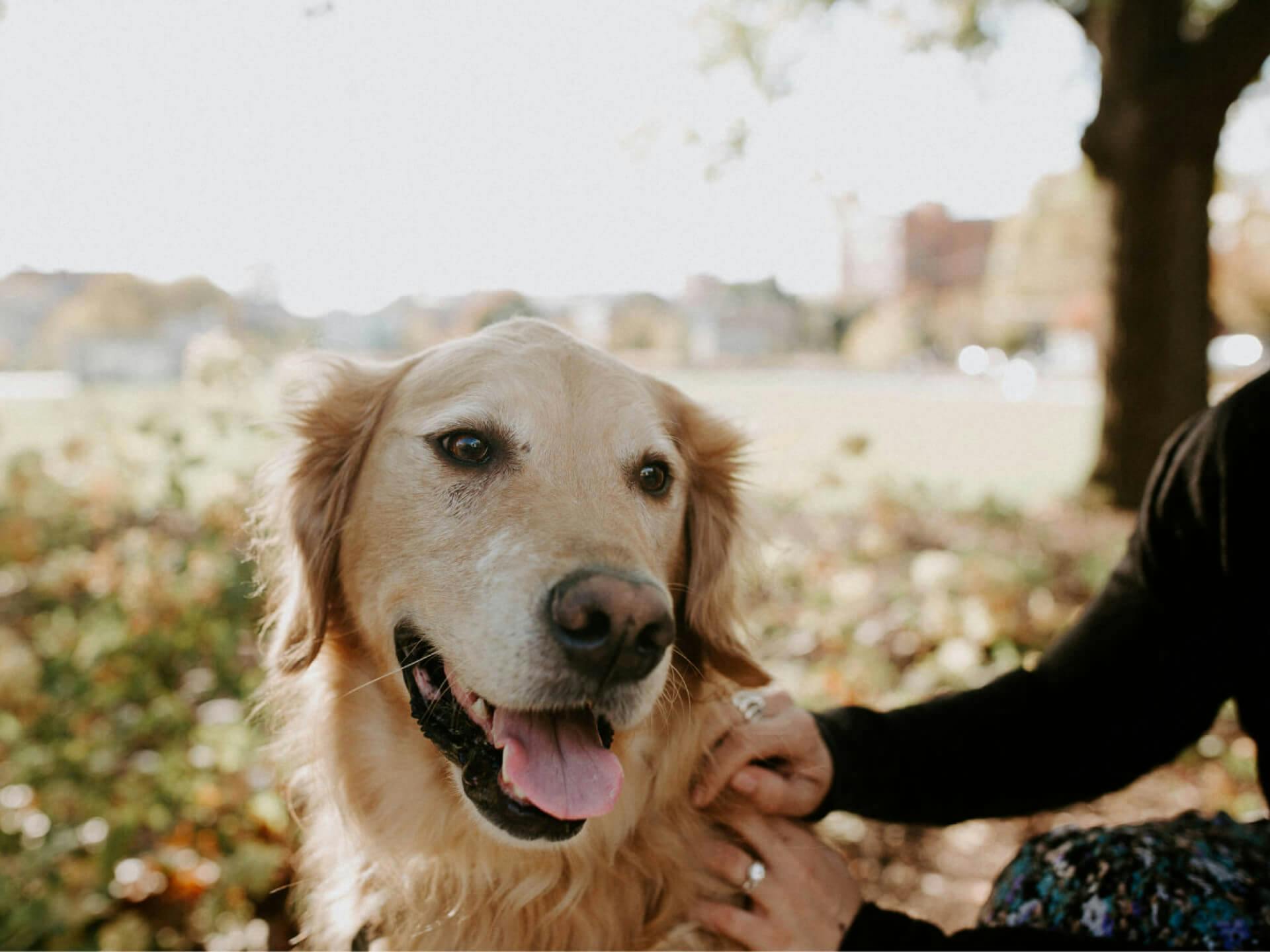
I quickly realized things haven’t changed much in a generation.
We worked with a trainer who we really liked, but that was an hour a week at most. So I ordered books. I watched YouTube. I scrolled Instagram. I bought DVDs. I even bought a DVD player to watch the DVDs I ordered.
And I went looking in the App Store for help managing it all. I was floored how behind digital pet products were.
In other parts of my life, I was using CrossFit, Oura, Strava, and Duolingo.
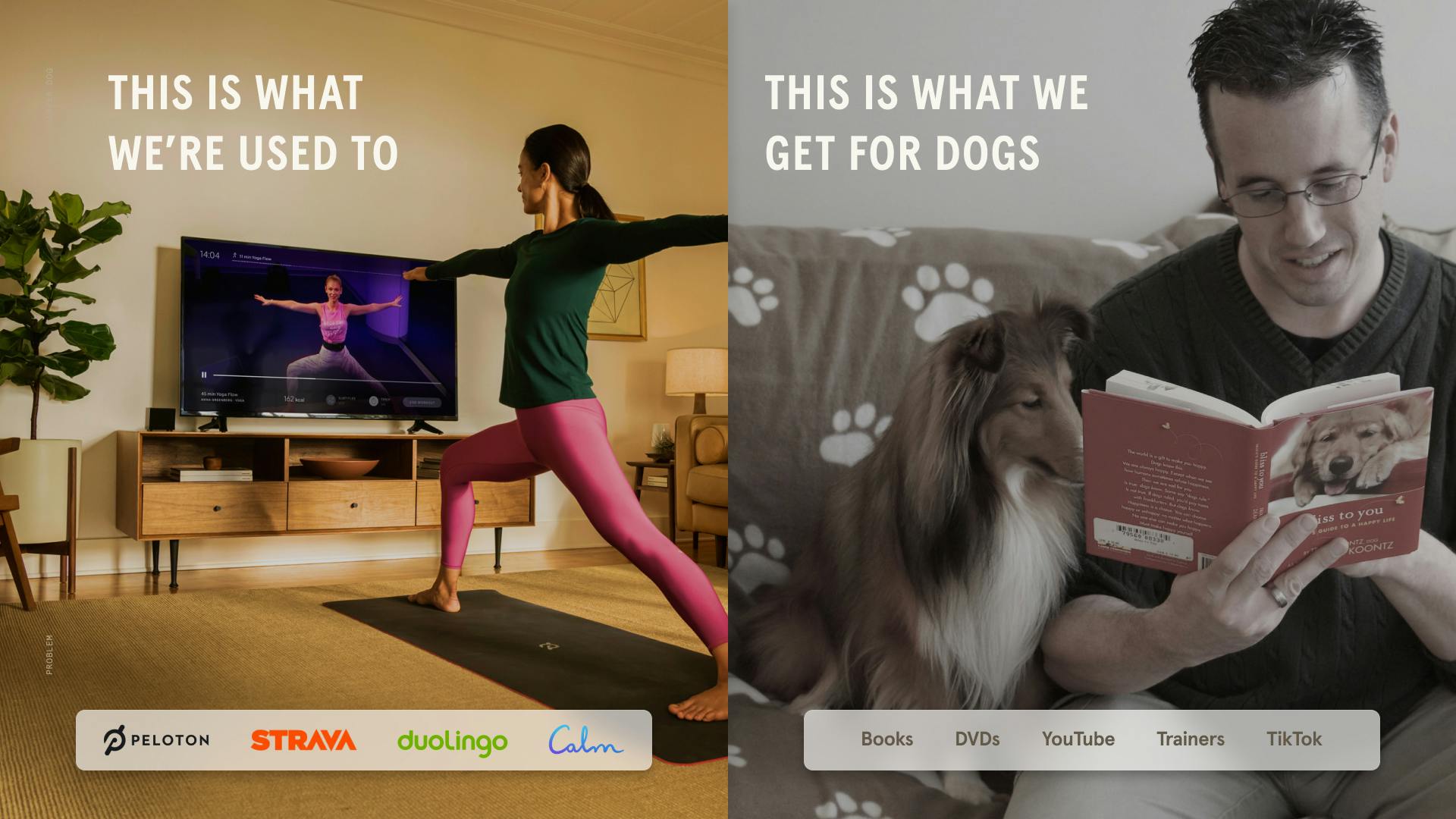
Talk about contrast.
For years I couldn’t shake the idea. Later I learned my buddy Robin (co-founder, engineer, ex-Ahalogy) had the same experience when he brought home his rescue pup Helo. We’d talk about it over dinner. We decided to do something about it.
“Why isn’t this simpler? Where’s the app on my home screen for all of it?”
Expertise and habit
There’s a lot of ongoing learning you need to do. No matter how old your dog is, you’ll find yourself having to search for and sort through a mountain of advice with a terrible signal-to-noise ratio.
On the other hand, you’re only as good as your habits. I learned that lesson from Leap.
If you don’t do the work at home to practice what the trainer taught you, it ain’t gonna stick. Consistency makes change.
And to keep a set of regular routines with your dog, you rely on all these utilities on your phone which have no context about you, your dog, your goals, or your environment.
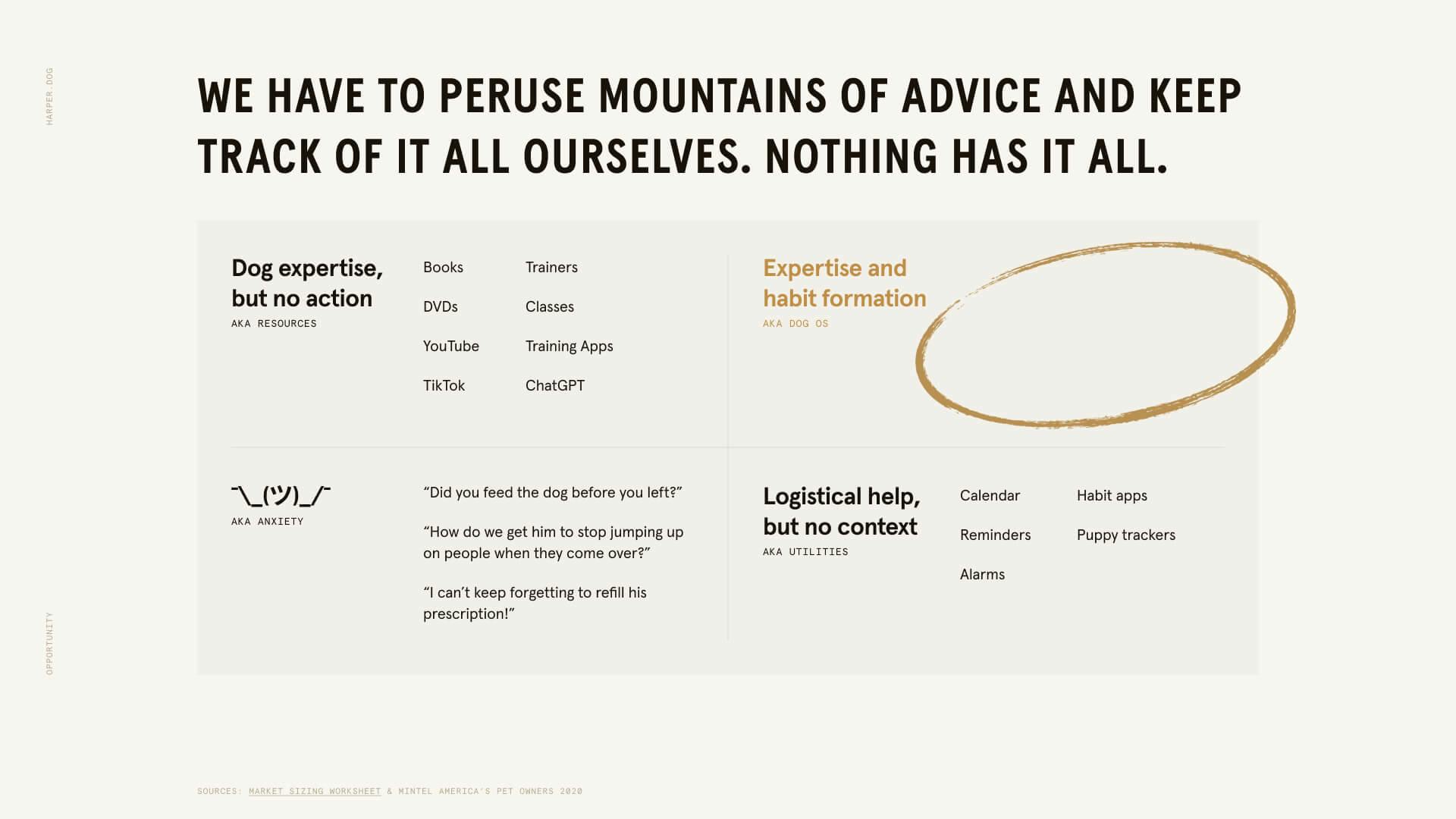
Era of isolation
As we journaled on our own experience and did research on our friends’ relationships with their dogs, we started to realize how much people counted on them.
When we talked to people, we learned how much companionship, sources of meaning, and healthy habits feel like they’re in short supply these days.
Deep down, a lot of the people I talked to got their pup because dogs can be a cheat code for all of those.
Why We Started HarperApp
Building a system of record for your dog’s daily life
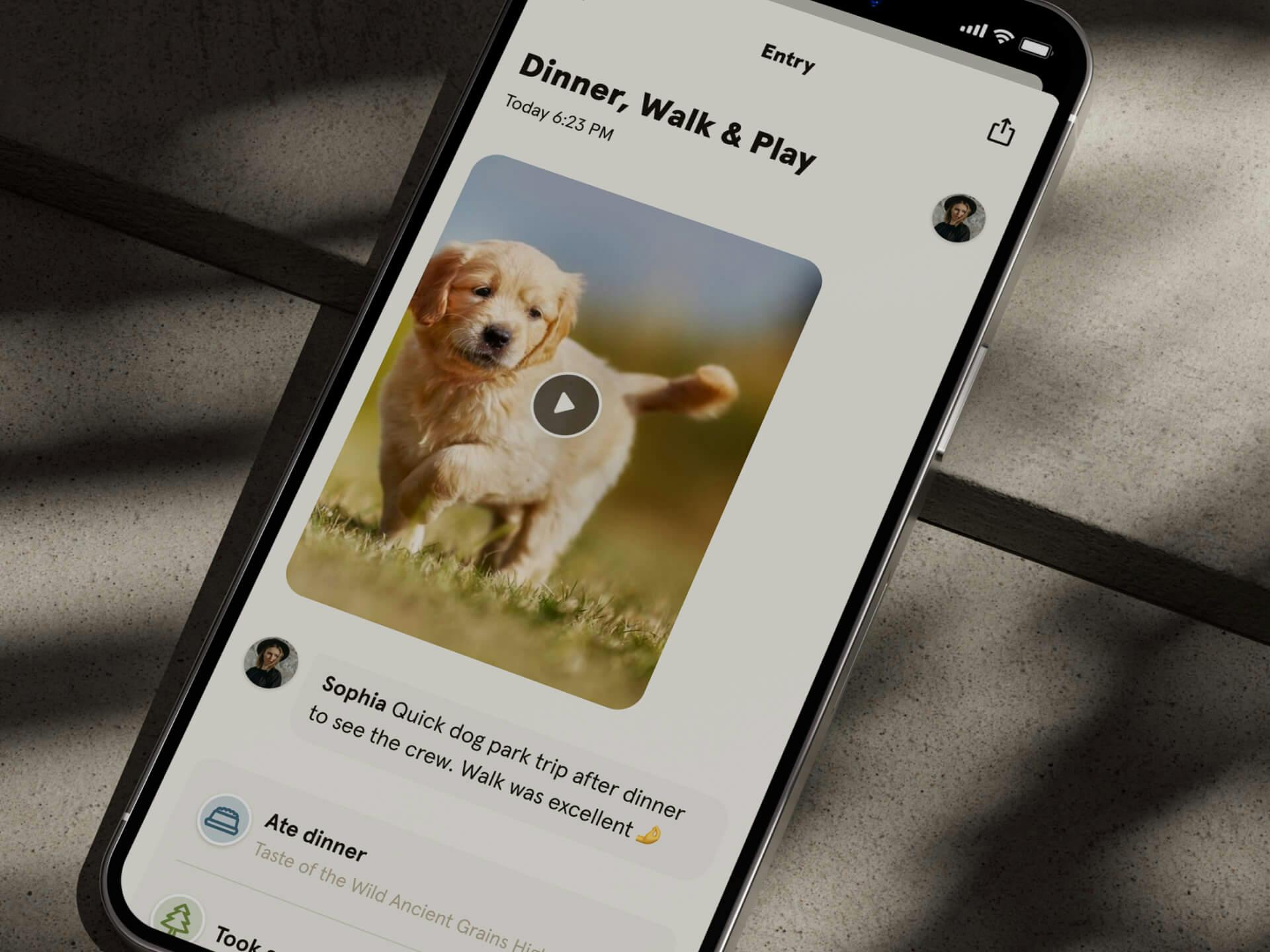
We built an iPhone app to be the thing we both needed. It evolved over multiple iterations from a training app, to asynchronous trainer coaching, to a daily home base for your relationship with your dog.
We focused on iOS. While iPhone market share in the US is somewhere between 39 and 55%, iOS was responsible for 66% of consumer app spend. Had to get that right first.
Robin built the app natively, teaching himself as he went. React Native apps have come a long way since 2020, but the user experience gap at the time was too significant.
We used equal parts UIKit and SwiftUI, relying on the latter more as it matured.

The back end was GraphQL, Rails, and Postgres—primarily because that was what we were used to and could move quickly with.
Robin built the app, the services, and the infrastructure. I’d edit copy, style, imagery, etc. directly via pull request.

Daily Schedule
The backbone of the app was a shared daily agenda for your dog(s), to help you stay on top of what they needed througout the day.
This is especially useful with puppies. They eat three or four meals per day and can need to go out as often as every two hours. Plus there’s exercise, medication, grooming, and training. It can be a lot.
Each pack—the dogs and humans living together—had a shared, editable agenda ready for them each morning.
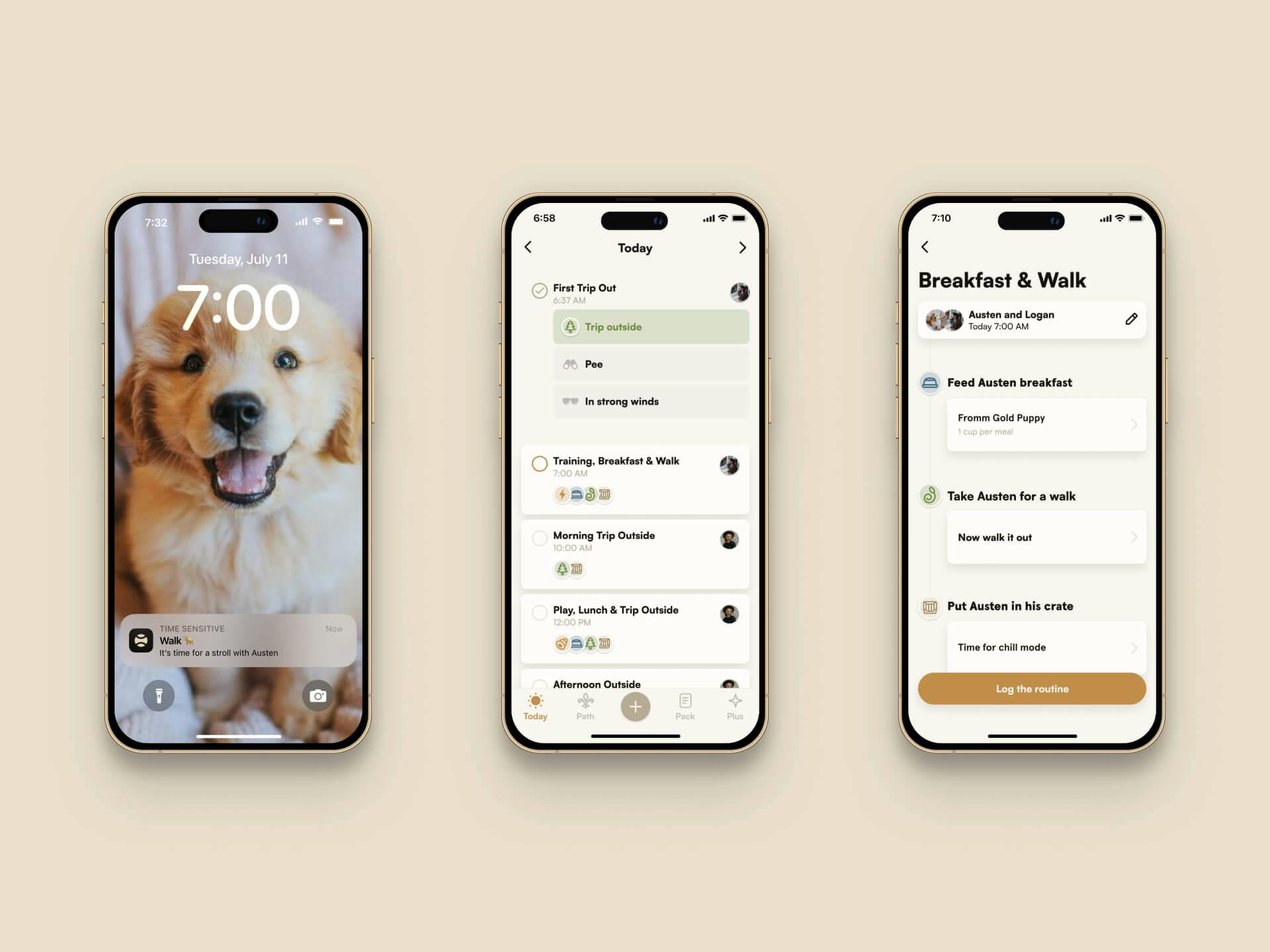
The activities that make up your dog’s day were intelligently batched into routines. It took advantage of research around habit stacking and meant there were fewer things to need to remember, and a higher likelihood of follow-through.
Each routine came with a time sensitive reminder push notification, personalized for the dog(s) and activity. Then on tap, you got a detailed checklist of what needed to be done at that point in the day.
In research interviews we found this gave the primary caregiver of the dog more confidence their roommate or partner could be counted on when they were busy or away.
Composer & Journal
Each routines was able to be marked complete and saved as a journal entry with caption, video or photo, and structured detail.
We tried to make it as effortless as possible to log the quotidien chores like trips outside, but full-featured enough for significant moments you wanted to save and remember.
For the small stuff, it needed to feel as simple as a checklist. For capturing the big stuff, it needed to feel like a composer in a social app. It was a tricky balance, and I don’t know that we ever got it right.
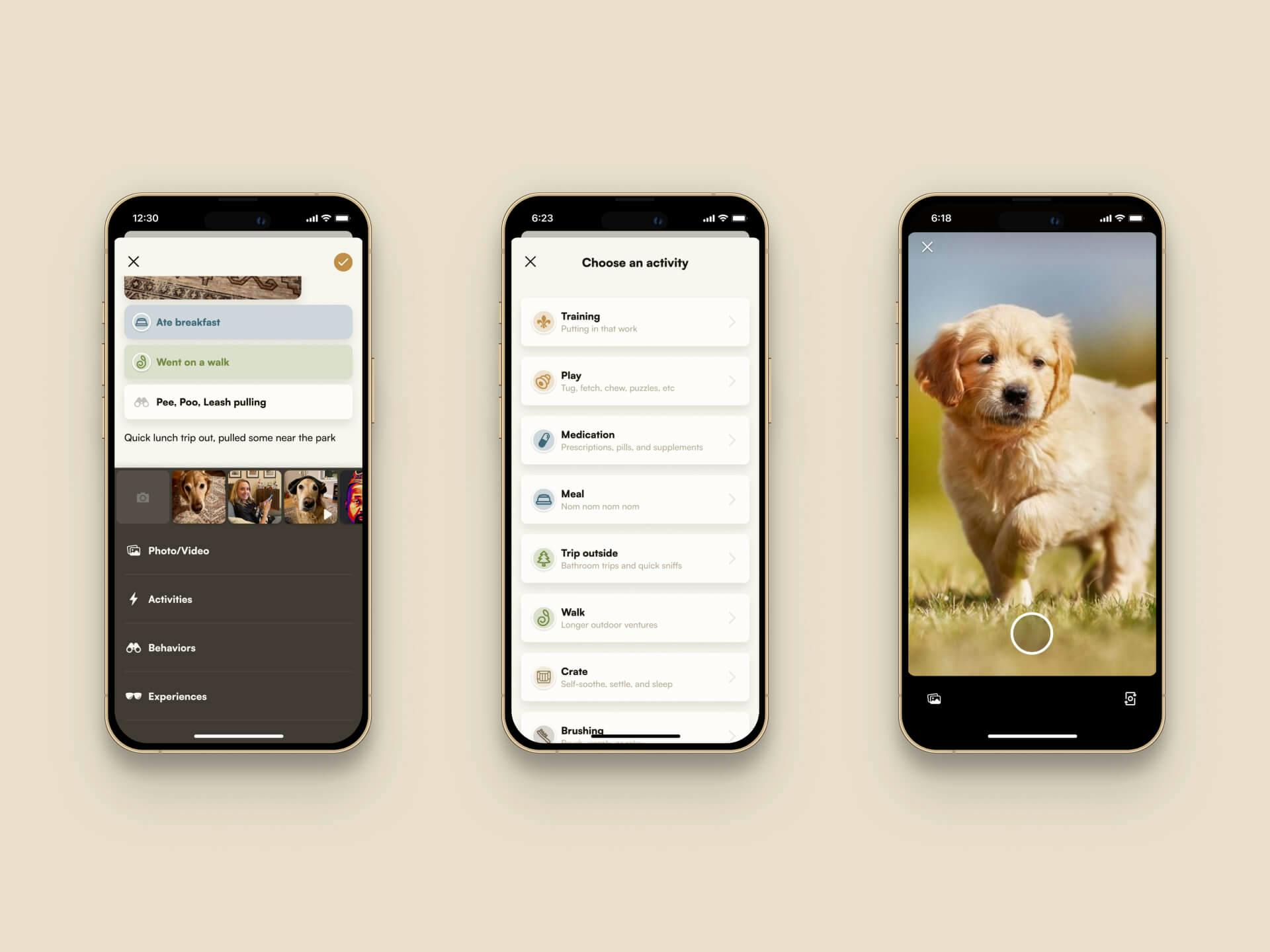
A saved journal entry automatically sent a contextualized update notification to any other humans in the pack.
For busy families, “Do I need to run home first and take the dog out?” is a question that shouldn’t have to be asked every day.
It was especially valuable when my wife was out of town for work. At a glance she could keep up with Fitzgerald’s day and feel more connected to what was happening back home.
And it prevented greedy Golden Retrievers like mine from hoodwinking you into giving them two dinners.
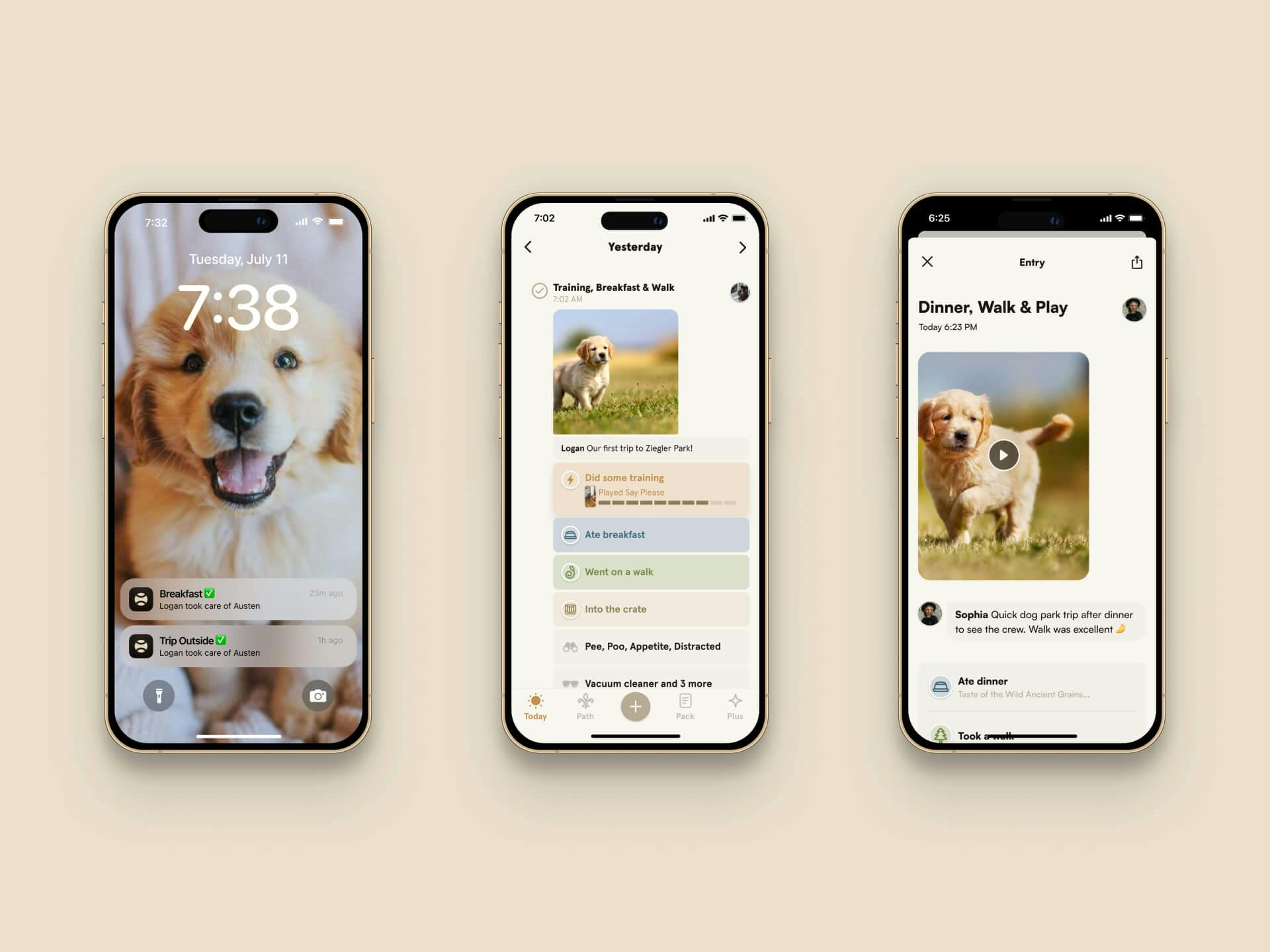
As you saved journal entries through the course of your days and weeks together, you built up a journal of your life together with your dog.
Your dog’s journal became the place you could turn for tactical reasons like tracking health changes and emotional ones like getting your fix of video from when they were a puppy.
Behaviors
We created a comprehensive list of bathroom, health, and conduct behaviors you were able to track.
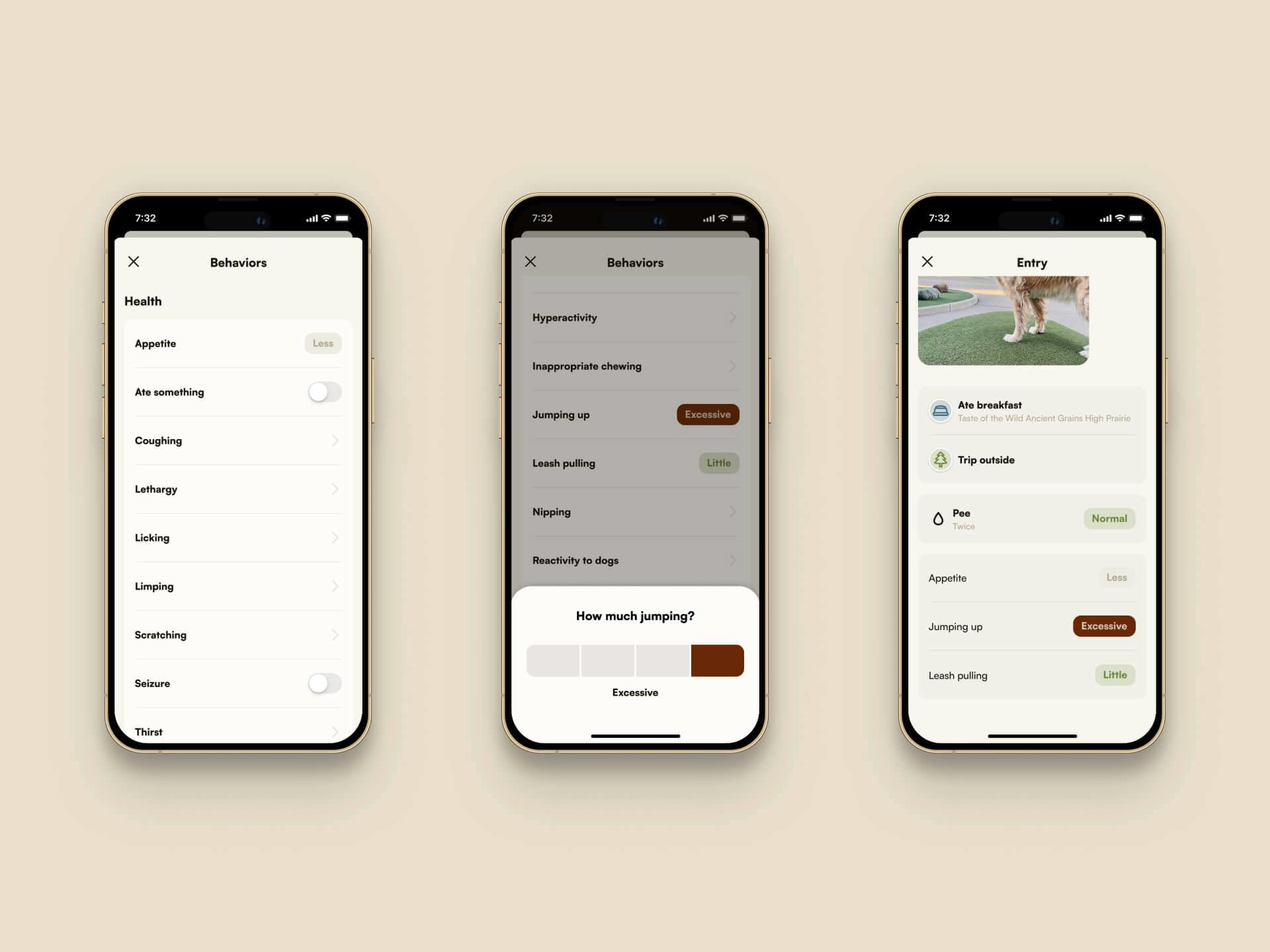
There were three important jobs to be done this solved for:
- For rookie dog owners, it taught them how to be better observers of their pups. Dogs actually tell us a lot. But if we don’t know how to see it, we don’t get the message.
- You could track their conduct over time. For example, did leash pulling improve during your walks this week?
- You could reference when certain health-related behaviors occured or changed. Sitting at the vet, it was nice to know with certainty the day when he lost his appetite or how many times he got sick.
Experiences
We also worked with a licensed animal behaviorist and trainers to develop what was the first (we think) interactive socialization tracker we called Experiences.
You were able to search, filter, and select the experiences your dog had and then evaluate their response to them.
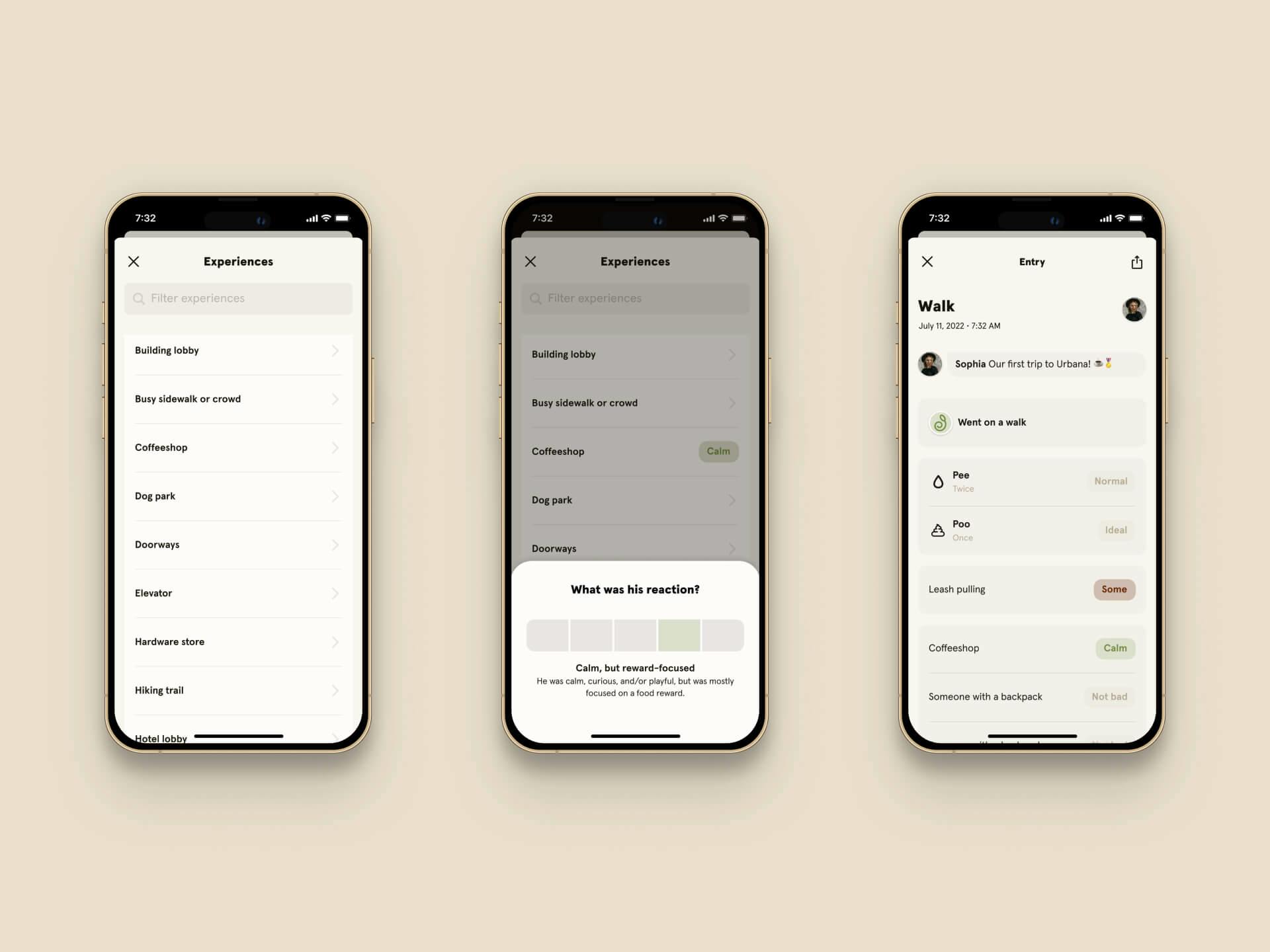
Giving your dog exposure to all kinds of sights, sounds, environments, surfaces, people, and other animals—especially when they’re young, helps navigate your world calmly and confidently.
Read moreTraining Curriculum
The core of our subscription tier Plus was our training curriculum of at-home training programs.
We created a library of 200+ video training exercises and bite-sized guides, organized into curated courses.
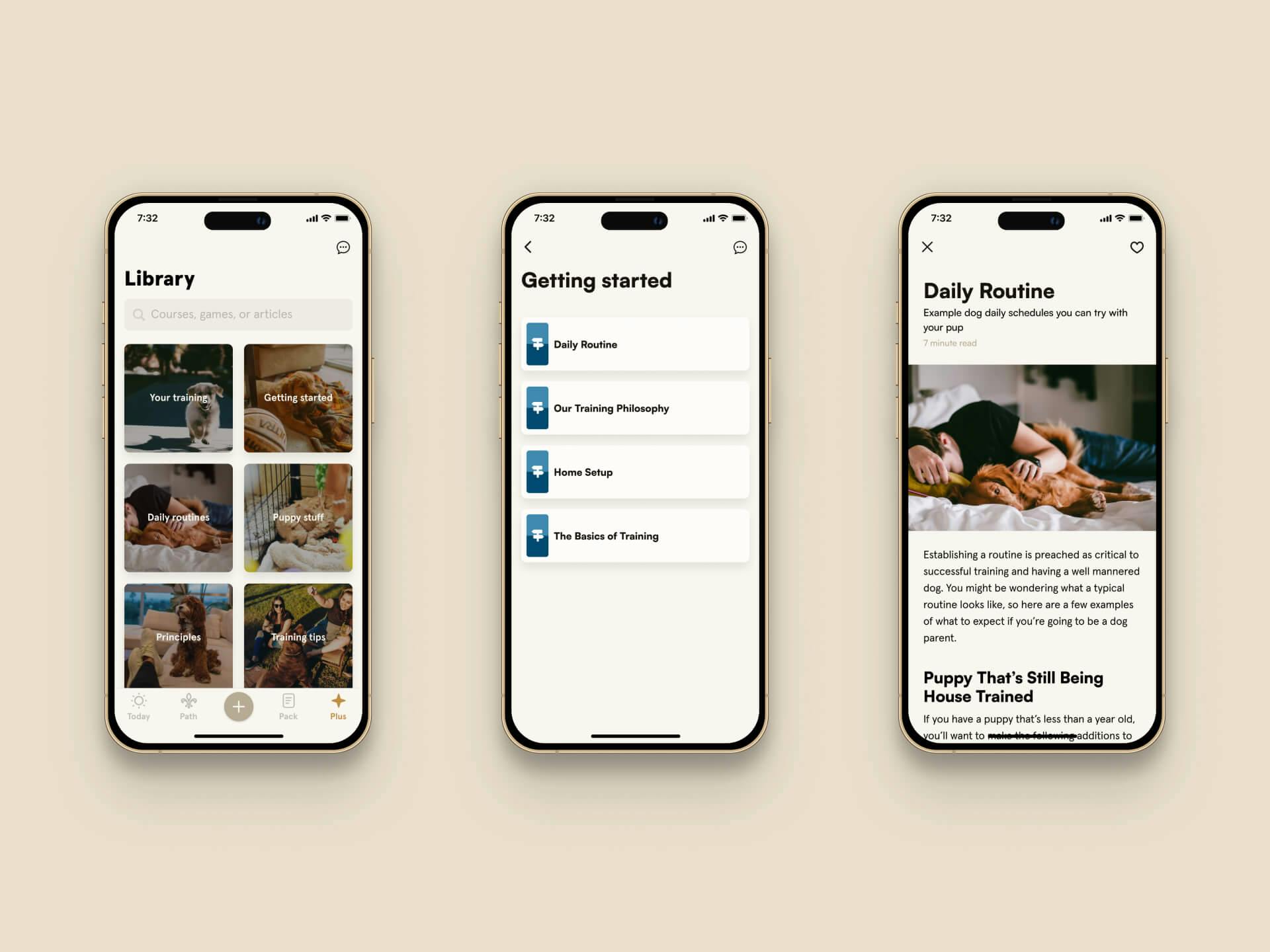
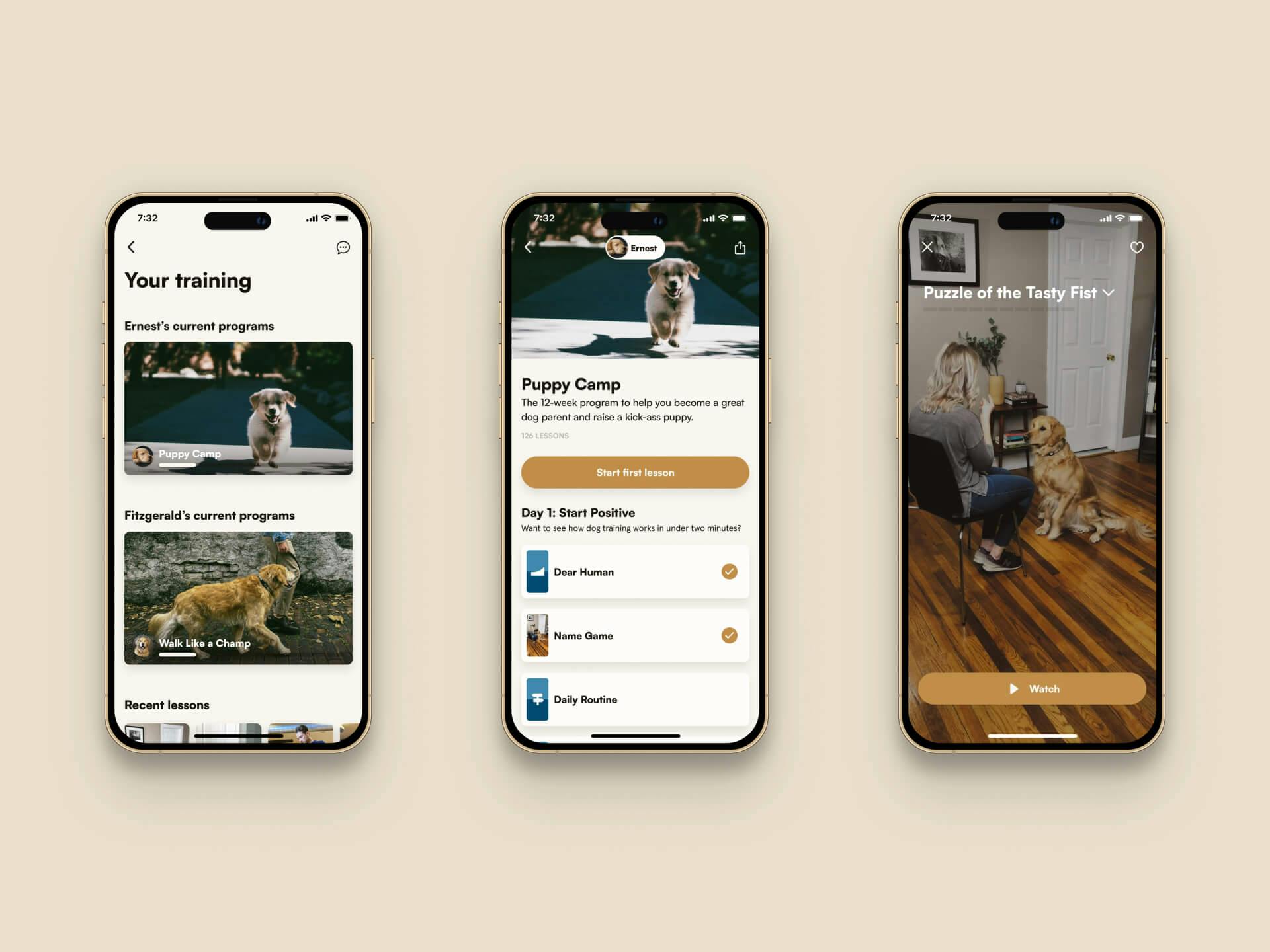
The training exercises were made up of step-by-step videos organized like stories.
This was born from our frustrations with YouTube videos, most of which had two signficant drawbacks:
- The camera usually didn’t move, pan, or zoom. A GoPro on the fireplace mantle seldom gives you a good view
- Too often I had to fast-forward through a 20-minute video to find the 30 seconds I actually needed
We wrote, blocked, shot, and edited the training videos specifically for this format, 100% in-house. It was one of the most lauded parts of the product:
I downloaded Harper a week ago and I can’t believe how great the content is and how much it’s already helped with our new Goldendoodle quarantine puppy!
The app was exactly what I was looking for. Short training snippets with great advice
I would recommend this app to any dog owners of any age dog. Great job Harper!!!
App Store review by “New Pup in training”
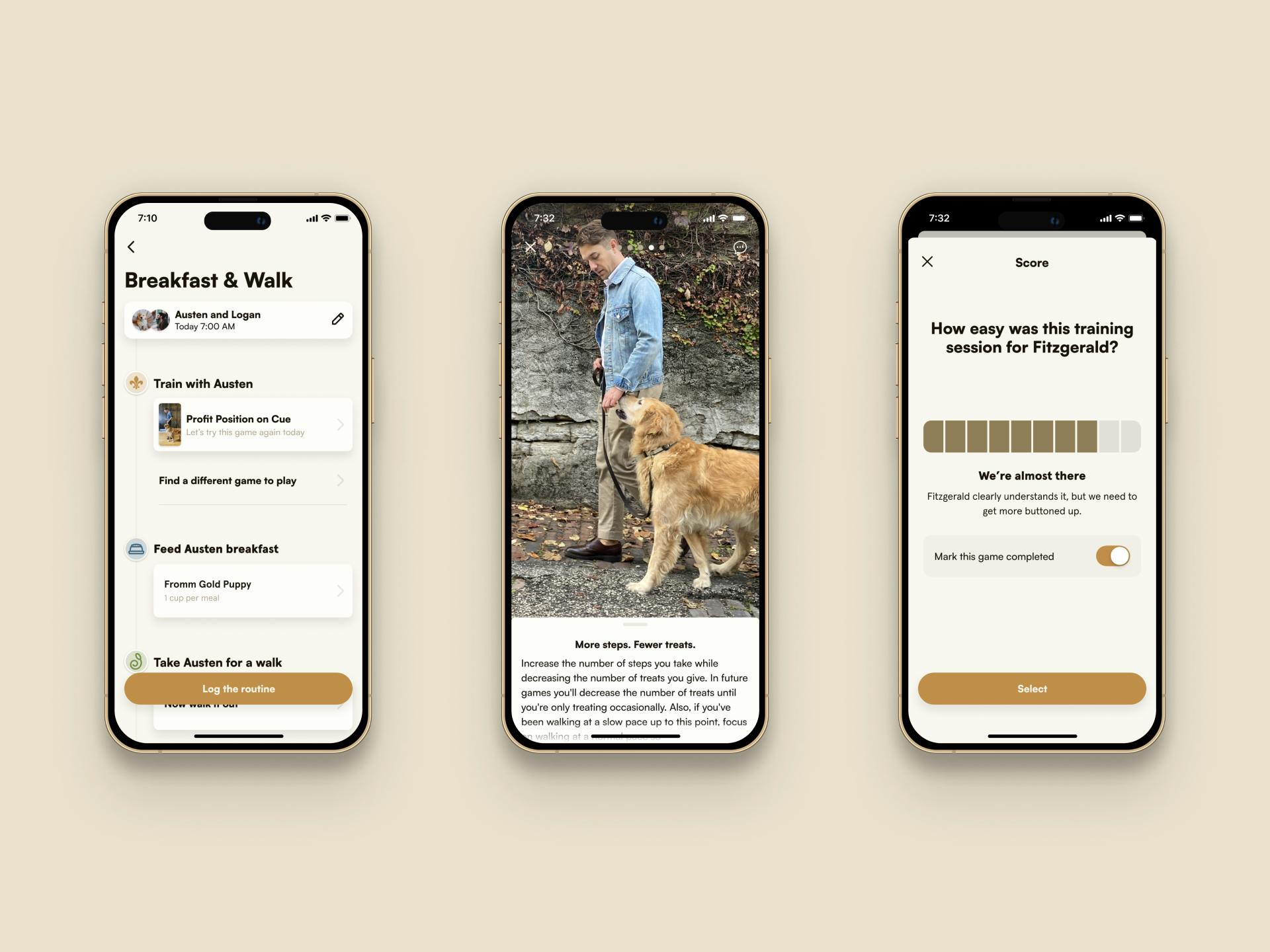
We also created an algorithm for making daily training recommendations. We based it on your onboarding placement as well as the dog’s past performance in Harper.
We designed and tuned it to balance the different kinds of training sessions a dog needs:
- Working on a new skill or new level of a skill
- Refining an exercise they learned but haven’t mastered
- Taking a step backward if they really struggled with something
- Reviewing past exercises to stay sharp
With a Plus subscription, the algorithm gave you the right training exercise for that day, added to your schedule automatically, with videos a tap away.
We also created a unique scoring scale to help new dog owners learn how to evaluate training sessions and learn what improvement looks like. The score completed the feedback loop and fed the algo for the next recommendation.
Training merit badges
Turning dog training into a game was an idea we were enamoured with for a long time.
Apps like Duolingo and books like Reality Is Broken bolstered my belief that there’s so much more that game mechanics can do to help people thrive in their daily lives.
For dogs, there are certifications like Canine Good Citizen and high-level obedience competitions. But they’re niche and not something most dog owners can or even want to pursue.
A lot of apps have badges of course. They've become a dirty word to some because of how often they're used to “gamify” behaviors that people just don’t really want to do. This was different.
We drew inspiration from scouting, the educational progressivism that inspired it, and a healthy dose of Duolingo.
We created 52 merit badges across 8 different levels to serve as a mental map for dog owners of the training that’s important for most dogs.
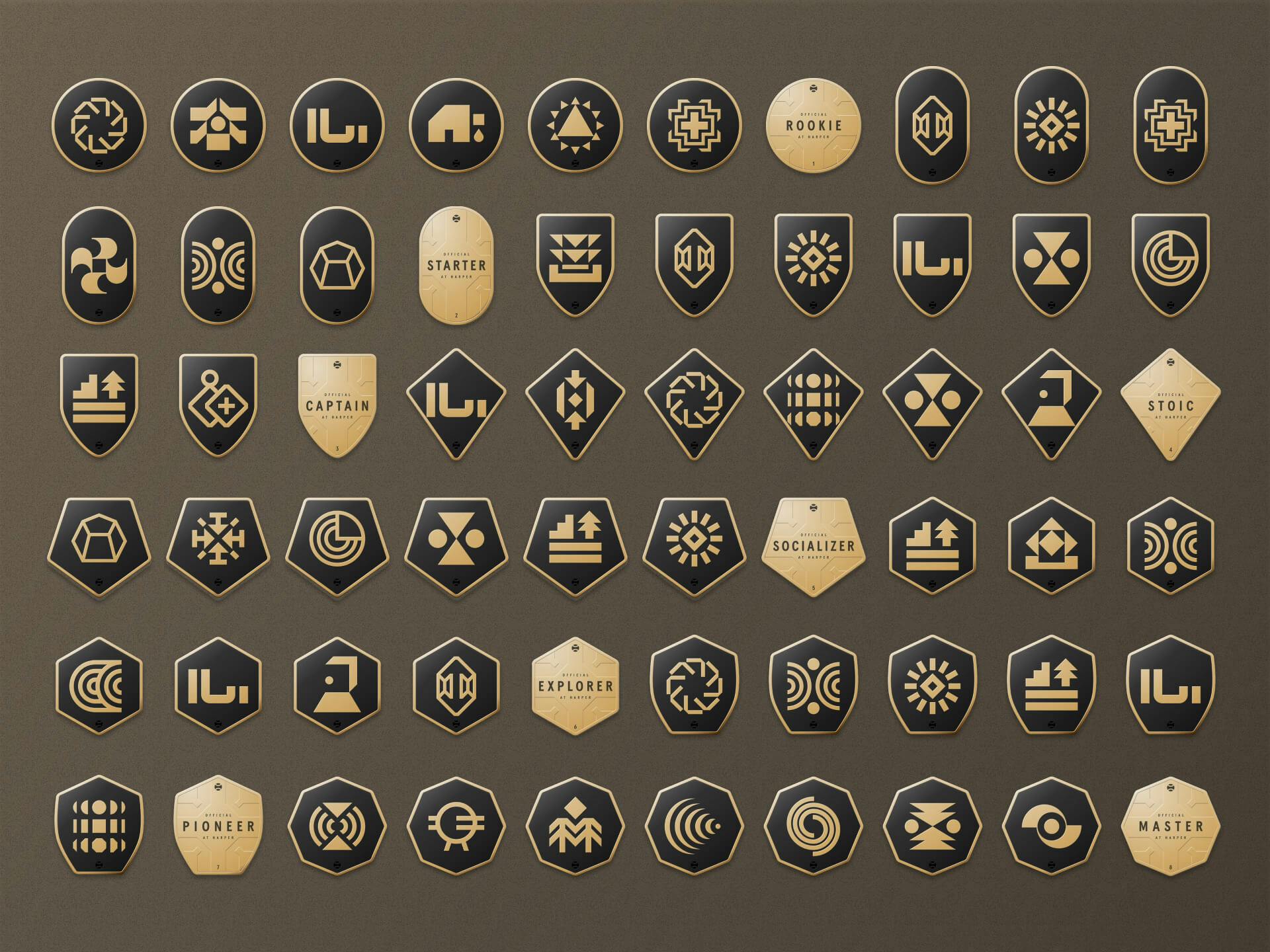
For the badges themselves, I collaborated with the talented Ethan Fender to design custom abstract iconography that represented the various skills in our training curriculum map.
Each merit badge required a real-life demonstration of a certain level of mastery of a dog training skill. They each had a list of standards to be met.
On advice from trainers, each level had to be completed before badges in future levels could be earned. This forced owners to work on all important skills, not just those which come naturally for their dog.
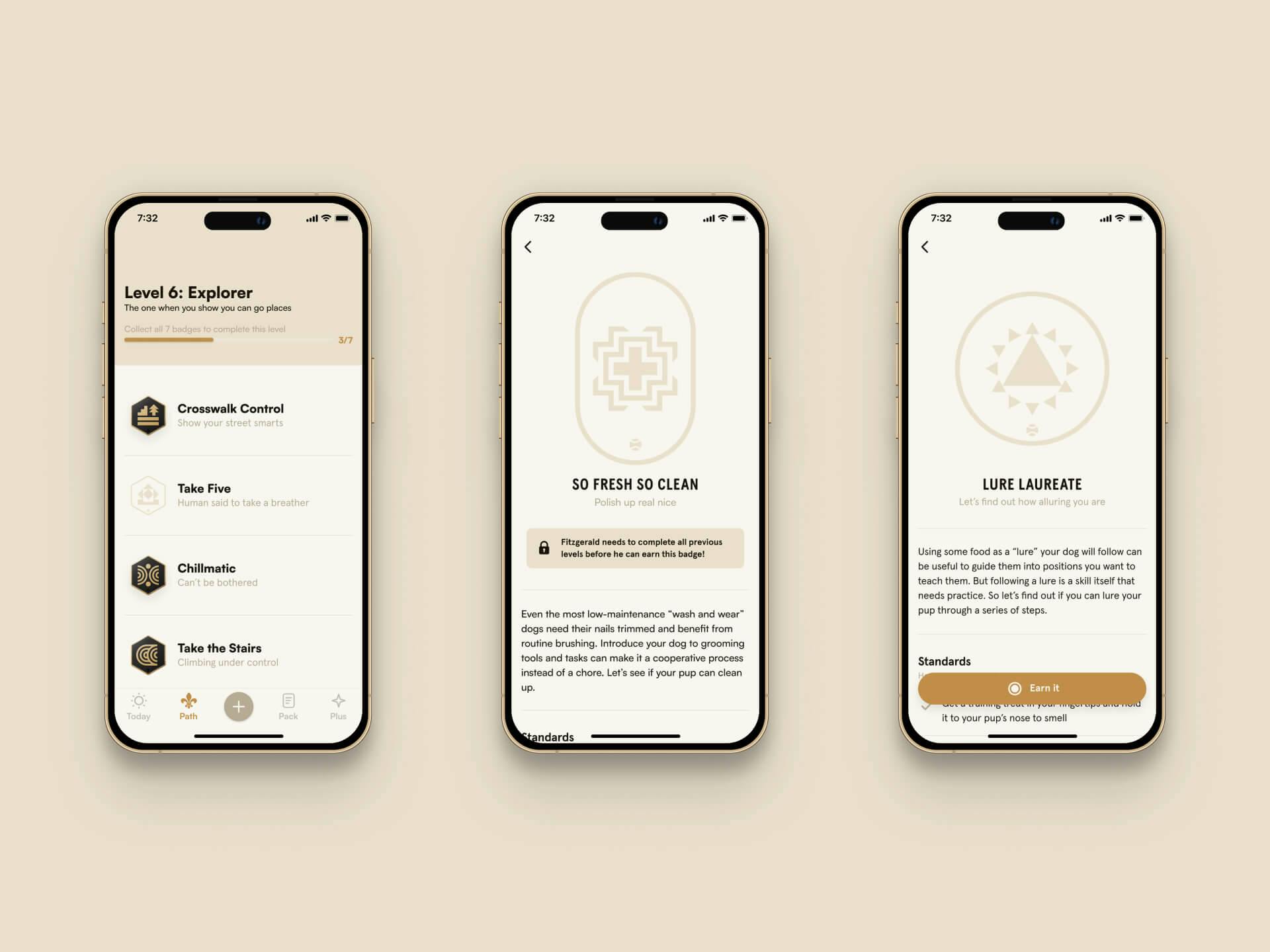
To earn a merit badge, you capture and submit a video of you and your pup completing a given real-world scenario. Upon submission, the video was evaluated by a real human to confirm whether the standards of the badge were met.
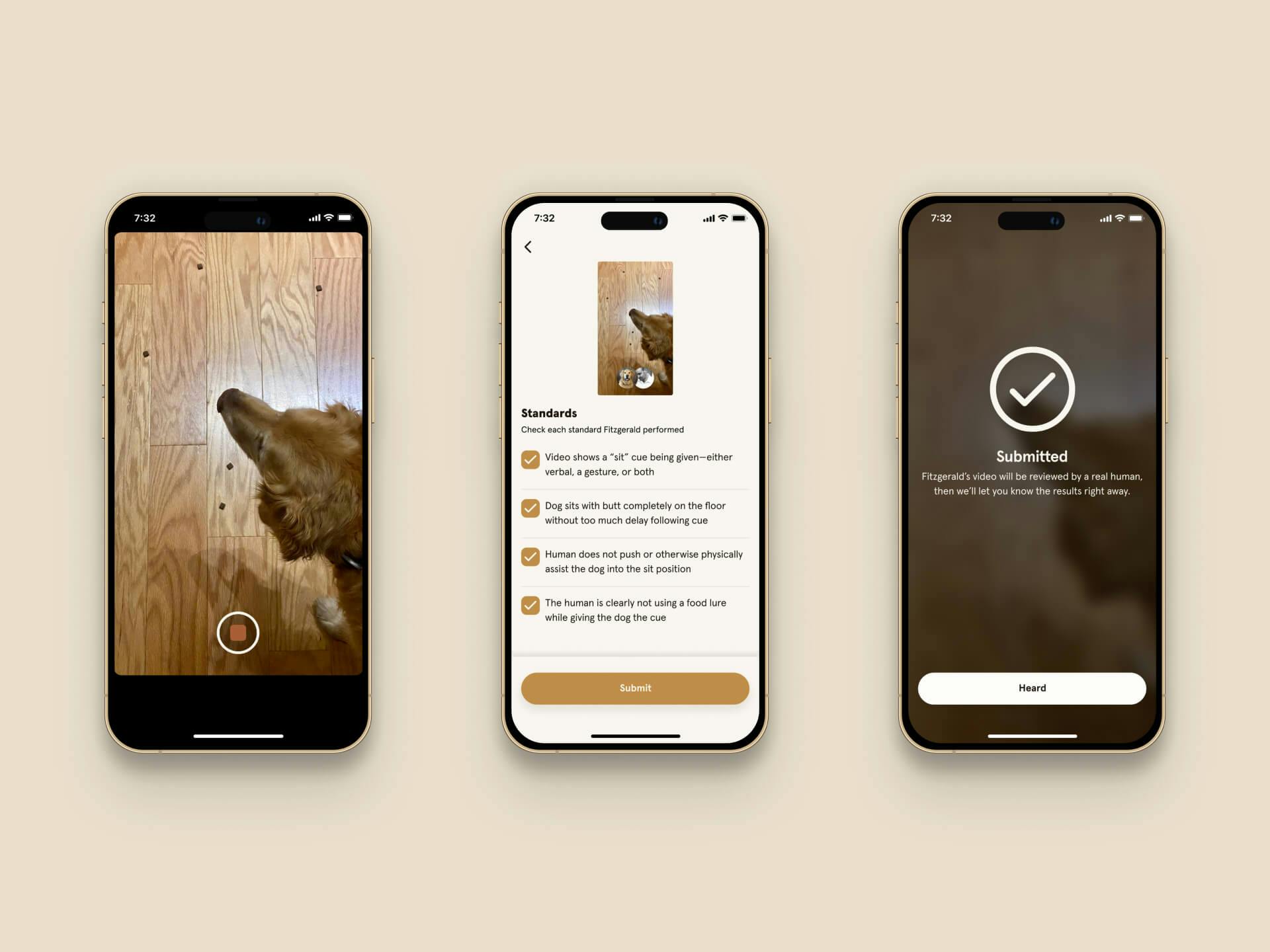
Once your submission was approved and a badge was earned, you received a push notification letting you know. On tap, you were shown the badge art in its full glory.
You were also able to share your badge win, either directly into Instagram Stories or via the UIShareSheet. The share asset showed the badge with your video playing in the background.
This style of share asset was also used for level crests, awarded when you completed all the levels in a badge.
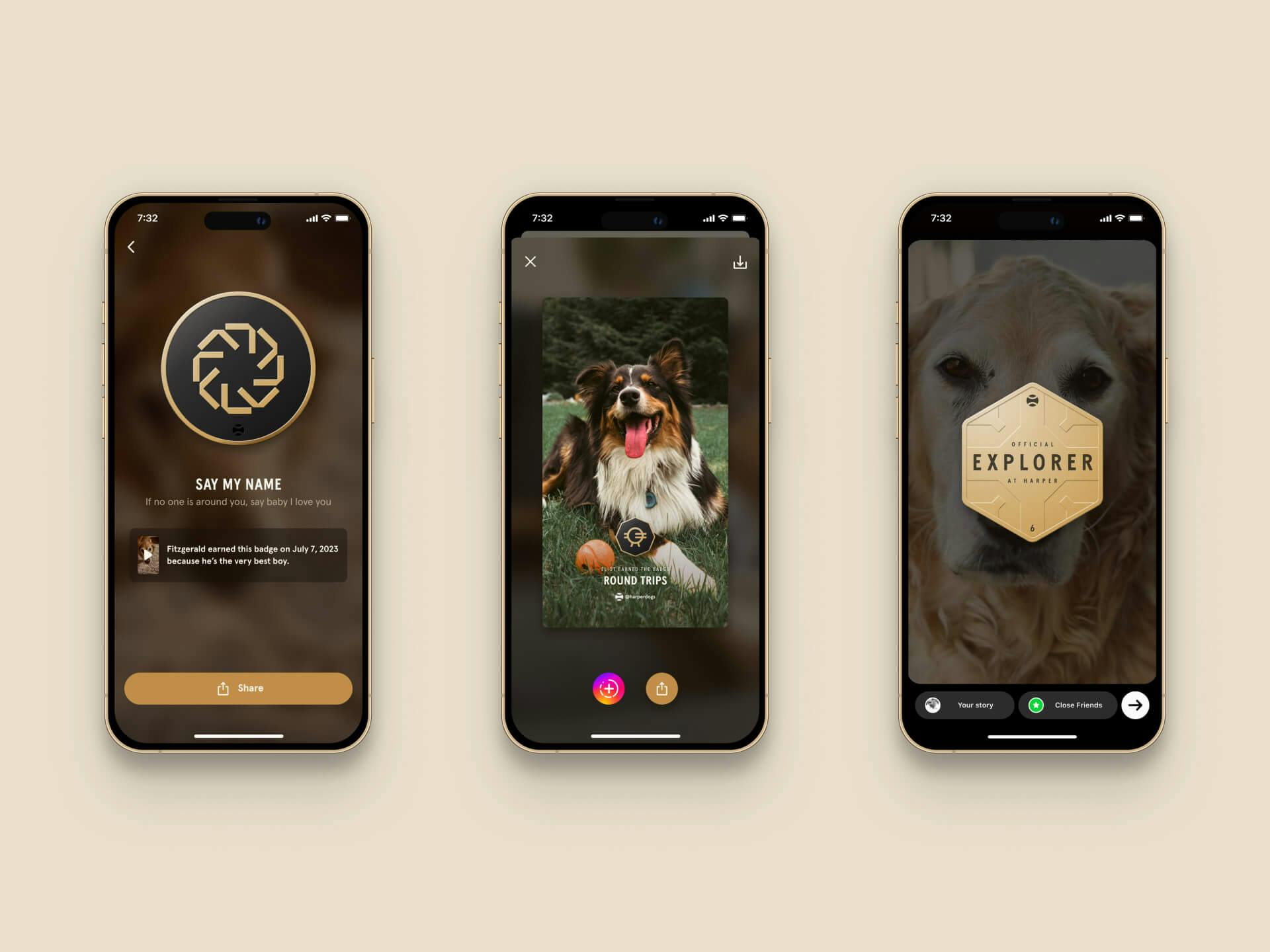
New user experience
No part of this app was iterated on more than the first mile. In the new user experience, you walk a tight rope, balancing at least three competing priorities:
- Keeping it short so time-to-value is quick
- Educating the dog owner on the app’s purpose, benefits, and vibe
- Collecting information to personalize their product experience
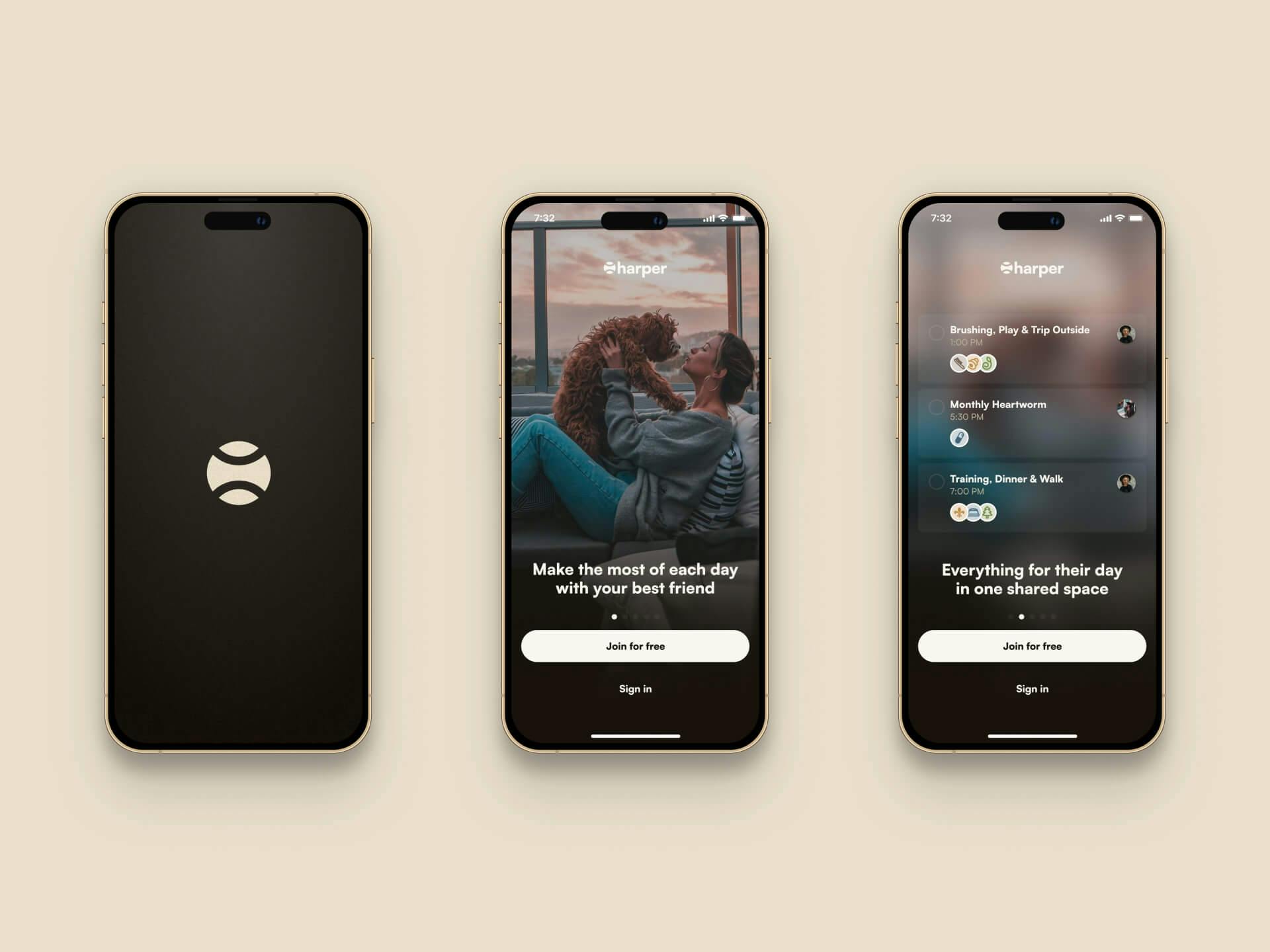
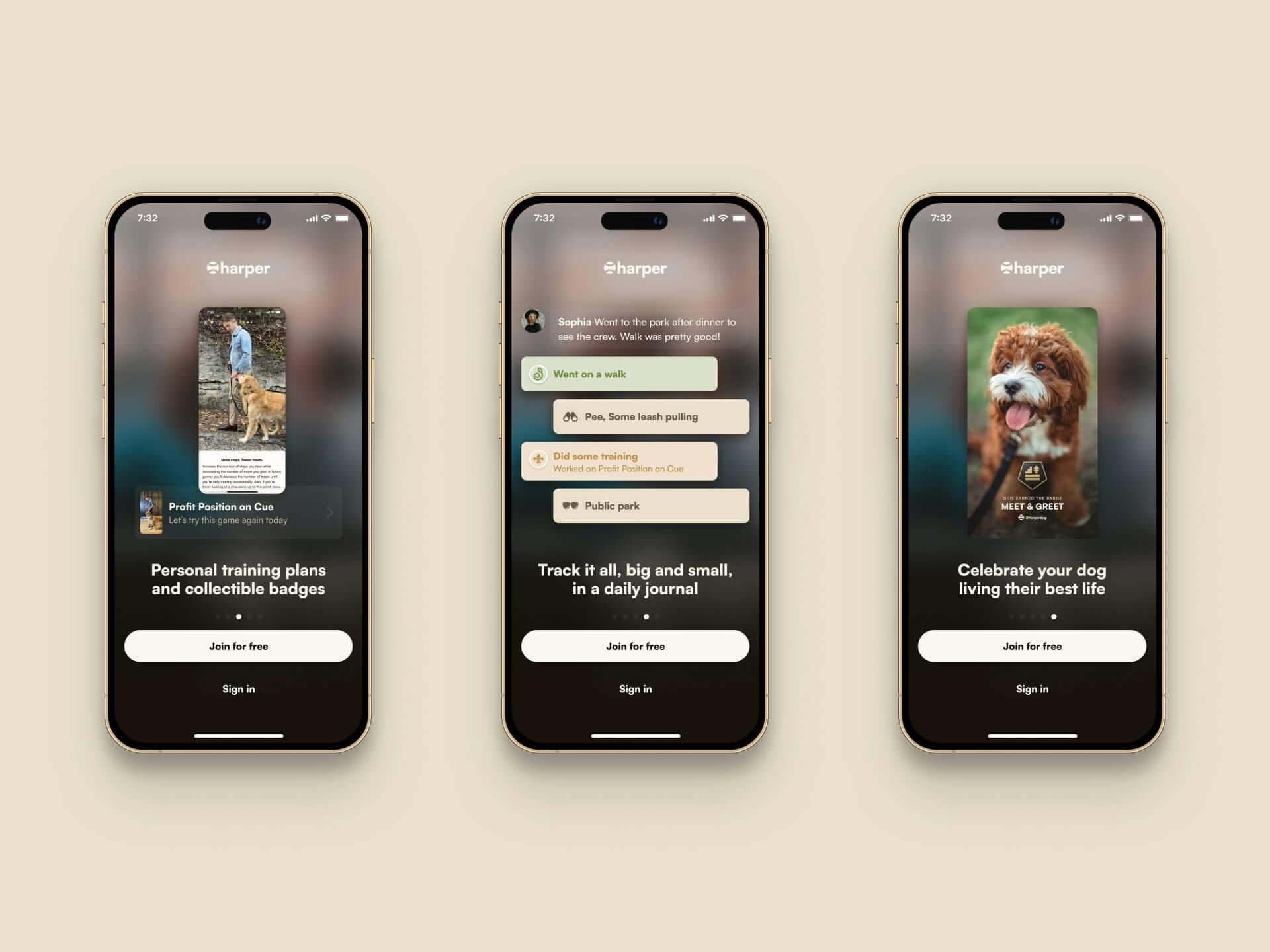
We asked a handful of intake questions about your dog(s), got your account created, and asked when your household started the day.
Using that information, we automatically generated a recommended schedule for your pack, which you could edit to reflect any existing routines.
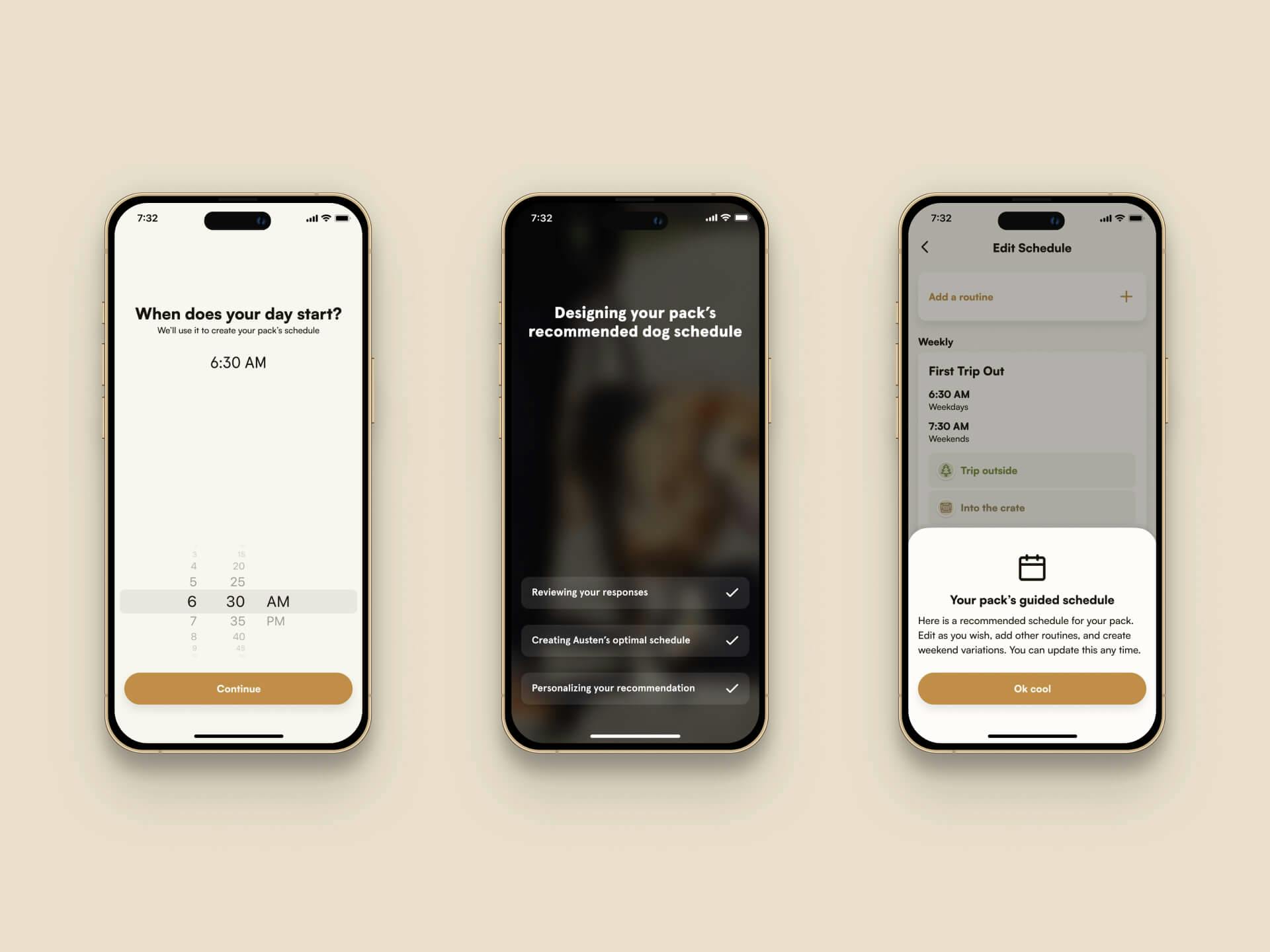
Immediately following the creation of your pack’s schedule was an organic place to prime and ask for notification permission.
We then led you to the schedule in the core of the app. We had the last few onboarding tasks as faux agenda items to teach you how to interact with the view.
If you lived with any other humans, we prompted you to invite them to the app and into your pack. And we guided you through the creation of your first entry, ostensibly to celebrate joining Harper, but also to show you how to create entries in the composer.
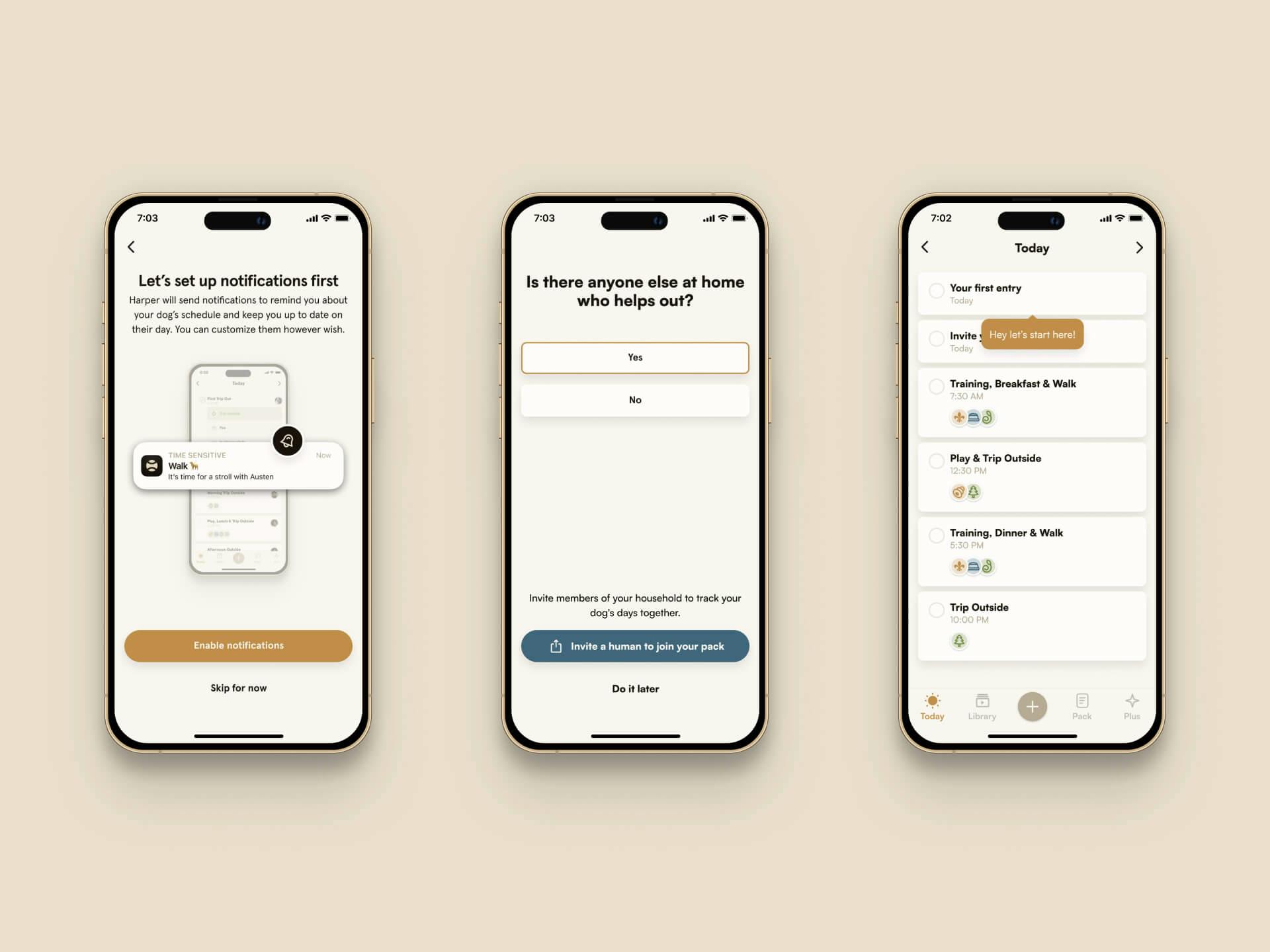
Subscription Flow
Plus was our membership subscription. With it you unlocked access to our training library, a personalized plan updated daily, and our Experiences socialization tracker.
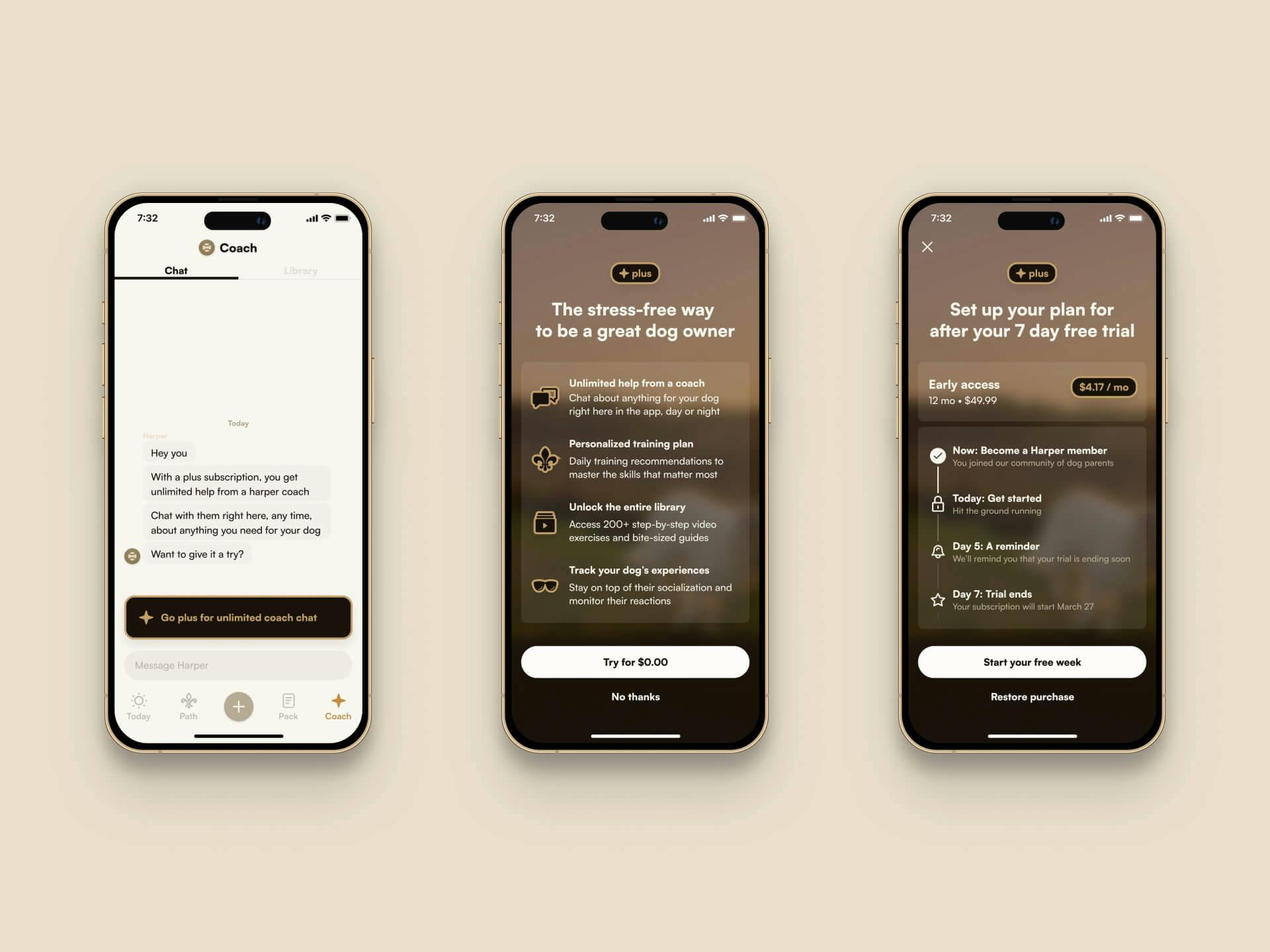
The JoinPrompt view was shown at the end of the new user experience as well as when you tried to access a paywalled feature.
We borrowed patterns liberally from other successful consumer subscription apps, because if there’s one thing that scale and a boatload of venture capital gives you, it’s the ability to split test and optimize your subscription flow.
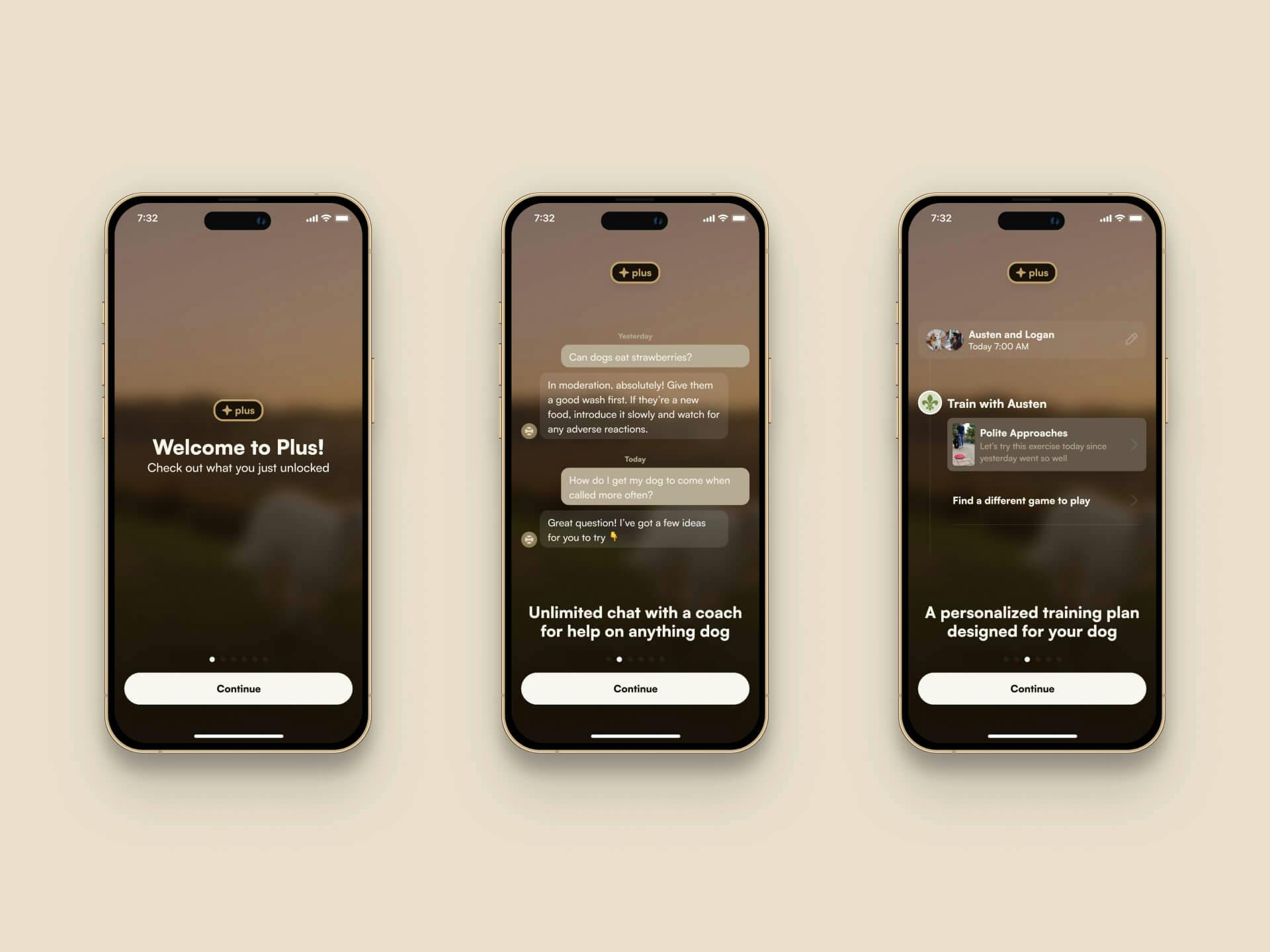
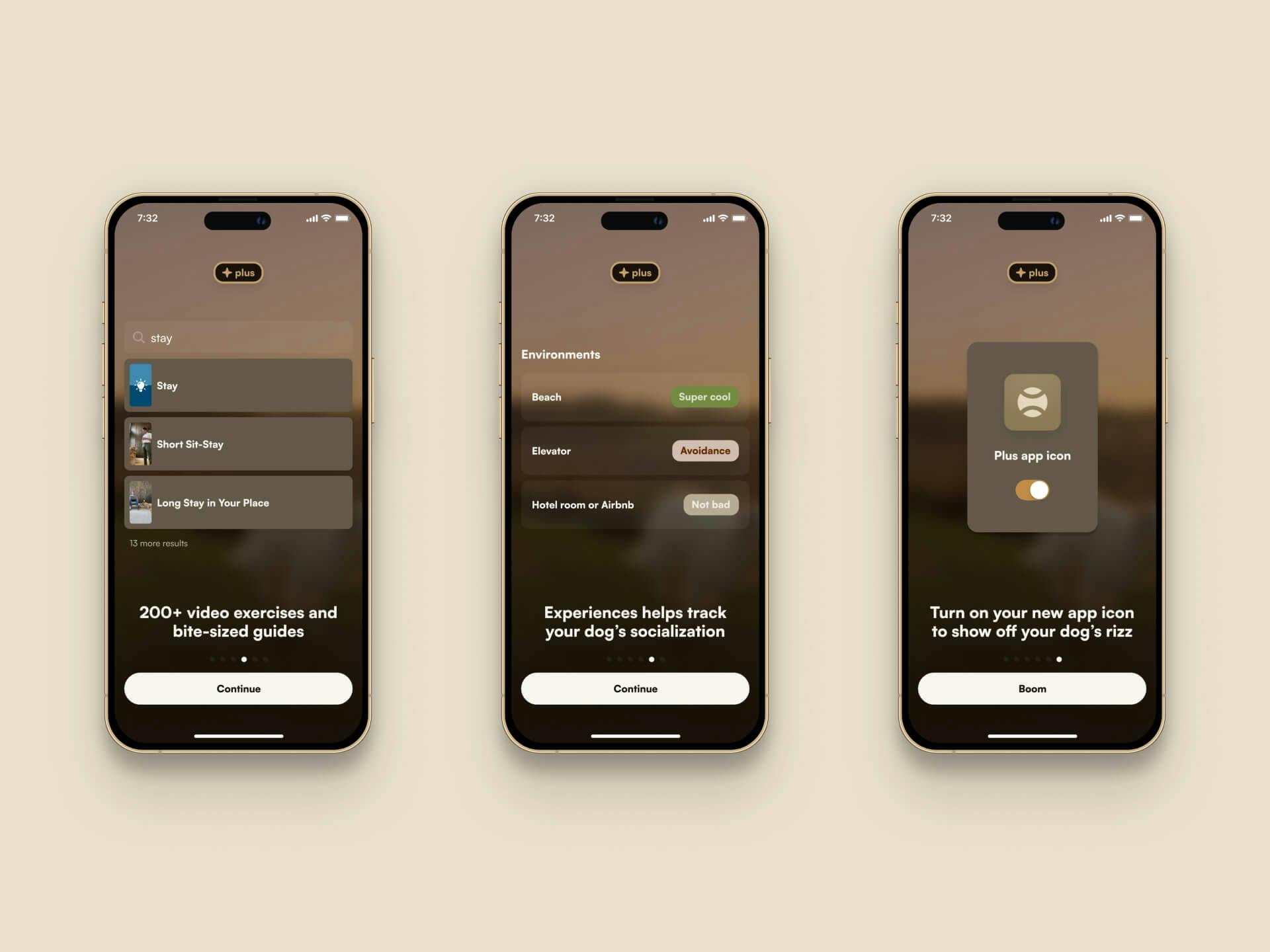
Following the in-app purchase (via RevenueCat), we showed a carousel educating our new member on what comes with their subscription. So many apps fail to do this, and instead dump you back at the root of the app where it appears nothing has changed.
Instead, we highlighted the core benefits of the membership, and signified the change in status by giving them an upgraded app icon.
Identity
Trying to design a pet brand identity that isn’t lame
For some reason, which to this day remains a mystery to me, the pet industry is almost entirely devoid of taste. It’s mostly cutesy copywriting, bad dog puns, and worse design.
There are some exceptions of course, but the bar is low and we needed to clear it.
Target Members
Our primary target members were new Millennial dog parents:
They recently got a dog. It’s their first pup living on their own, though many grew up with them. They live in an urban or residential city neighborhood, often with a partner, and sometimes with kids. They have laptop class jobs and work from home some days.
They use consumer apps like Netflix, Spotify, Calm, and TikTok. Most take fitness pretty seriously, using either a training app or a boutique gym. They travel.
They’re typically but not exclusively female, and they’re roughly 25–40 years old.
From our brand book
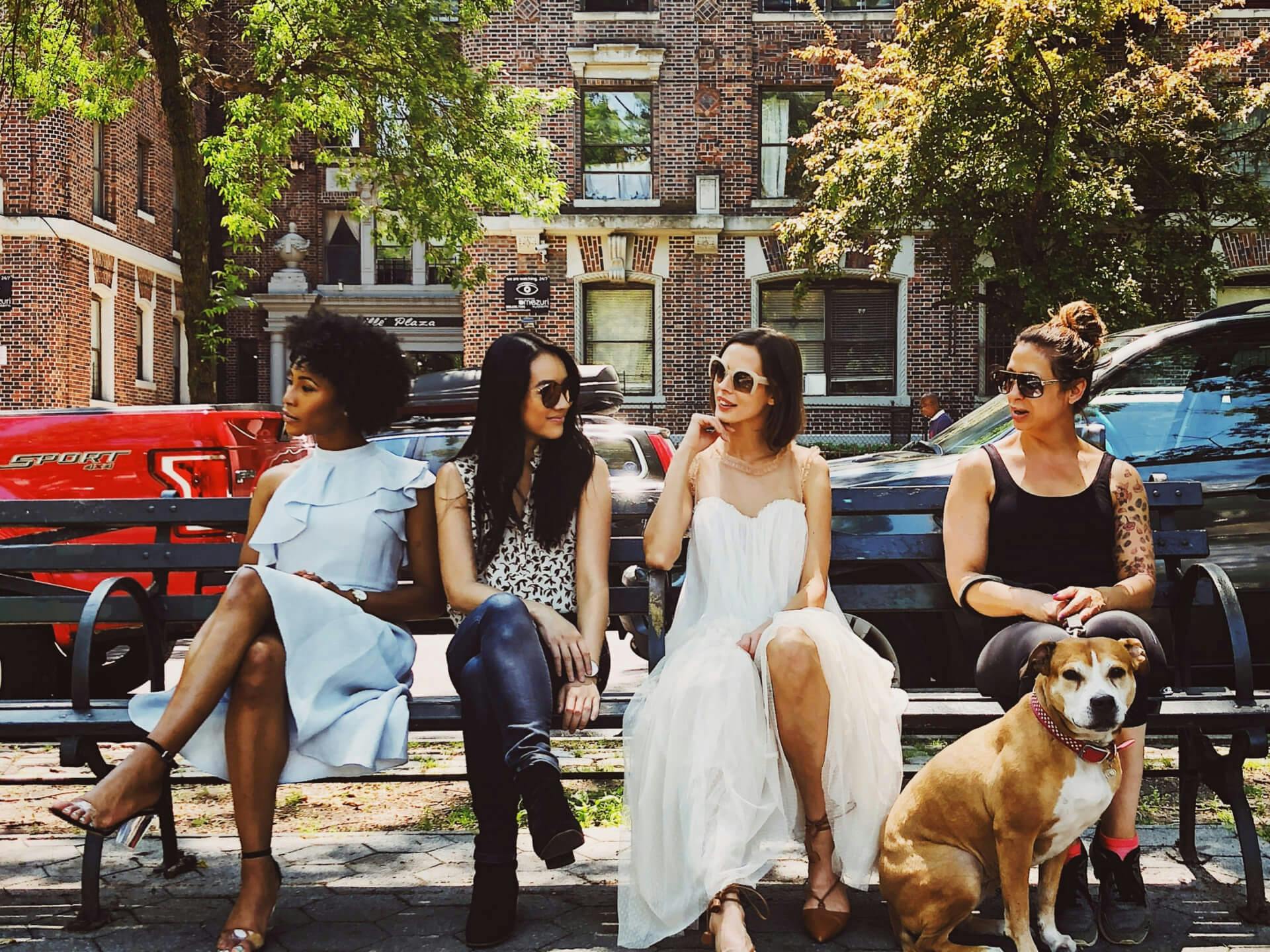
We needed a brand identity and vibe that was at home with Millennials, particularly on Instagram. I was inspired by consumer health brands to help it feel the right kind of high status for that audience.
It couldn’t be too eight-bit and game-like. For the most part this was not a Discord and Twitch kind of audience.
But it also couldn’t feel too premium. It was an app for your dog after all, and the subscription was a modest price point. You needed to sense that from branding.
Wordmark
I started with a tennis ball as our icon. From the perspective of a dog, tennis balls are bright and fun, part of playing a game, and often used as reinforcement for training.
I also believe in the idea of brands owning (or trying to own) an emoji in the minds of their audience. The 🎾 was a perfect fit. Not too on the nose, but IYKYK.
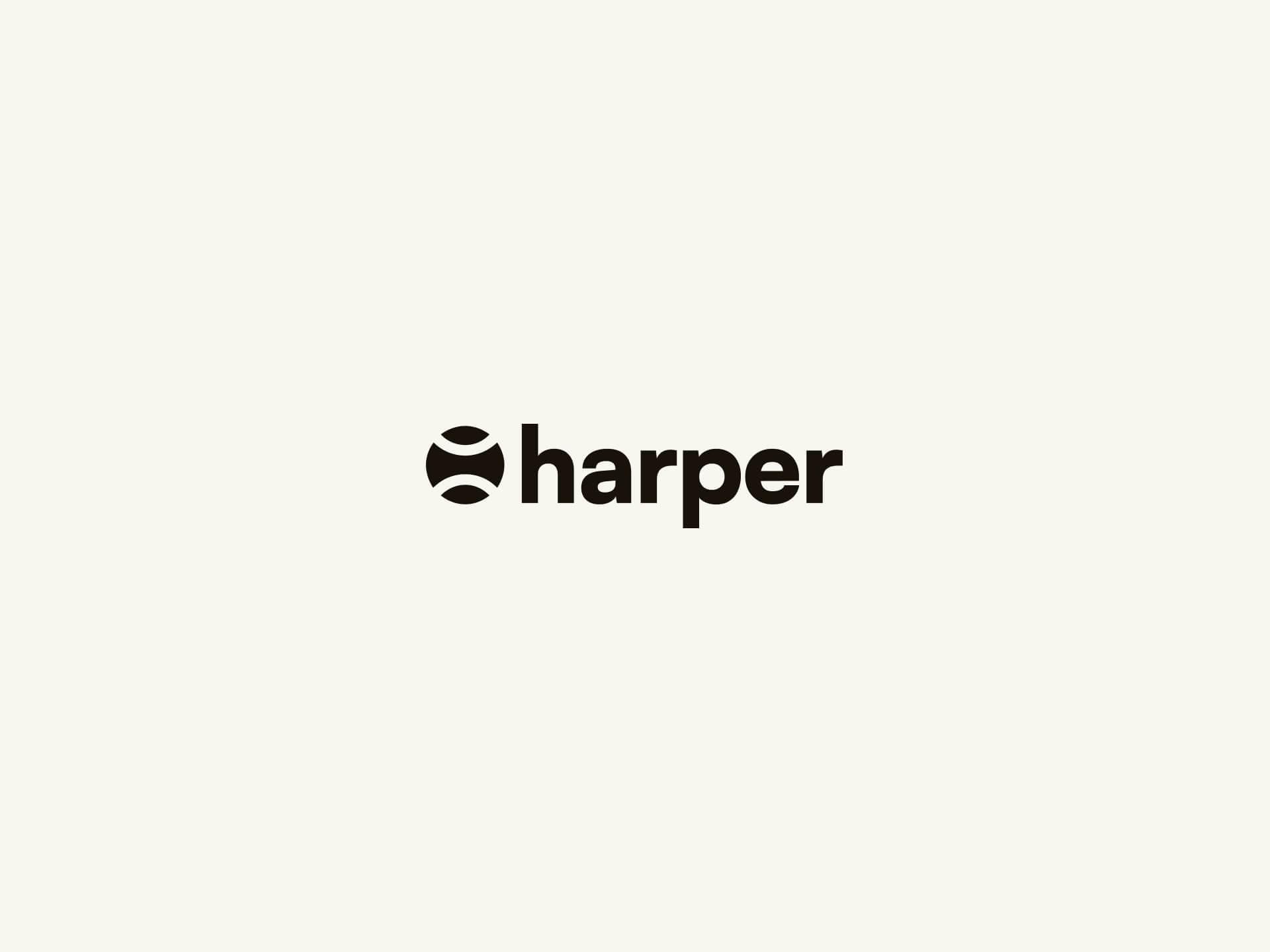
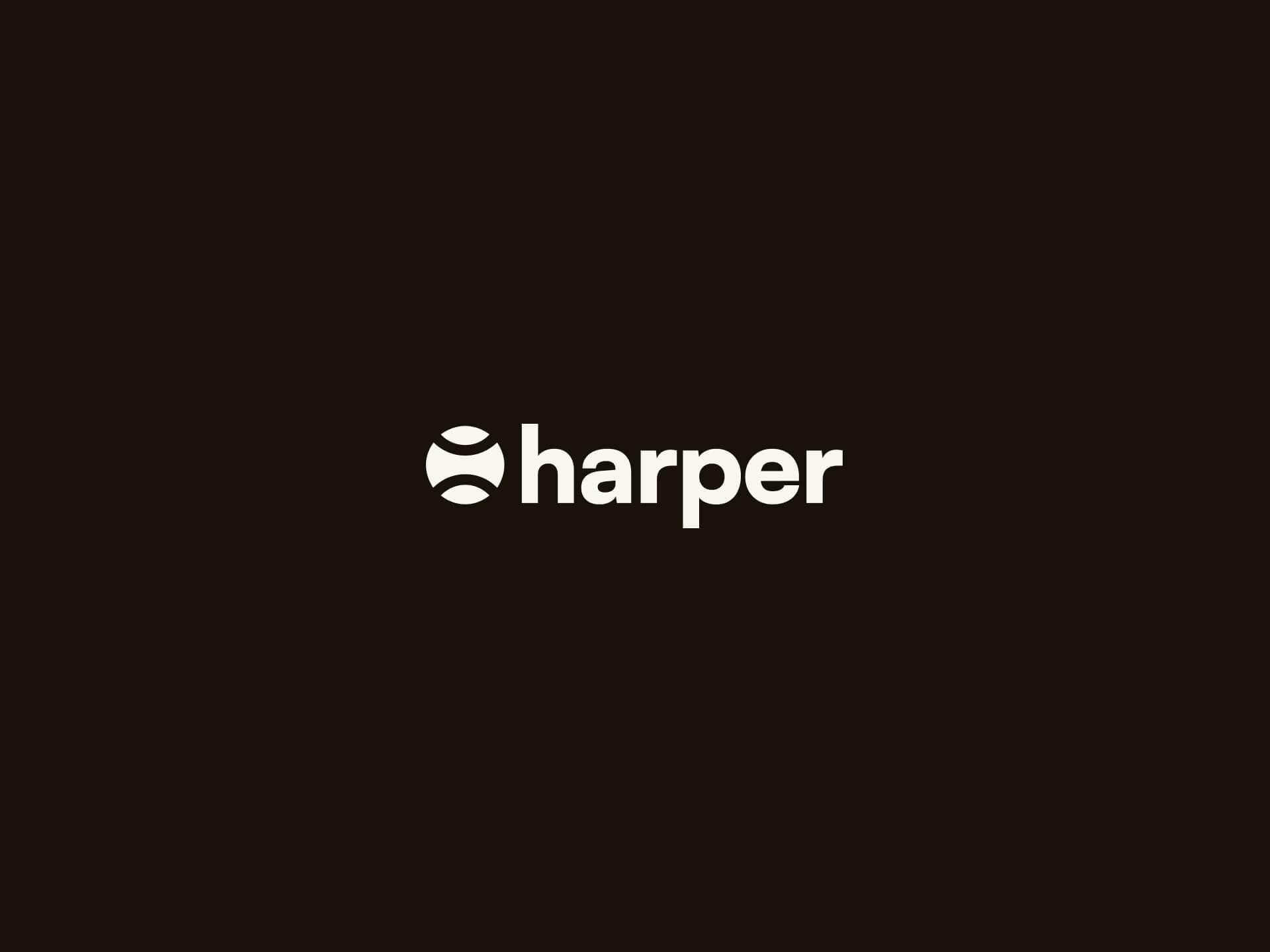
Color & Type
I paired the tennis ball icon with a wordmark using Aperçu (and then later Satoshi).
It’s a popular grotesque sans serif typeface, which makes it feel like it belongs in an app, but one that doesn’t take itself too seriously.
We supplemented that with a secondary condensed sans and serif faces for headlines.
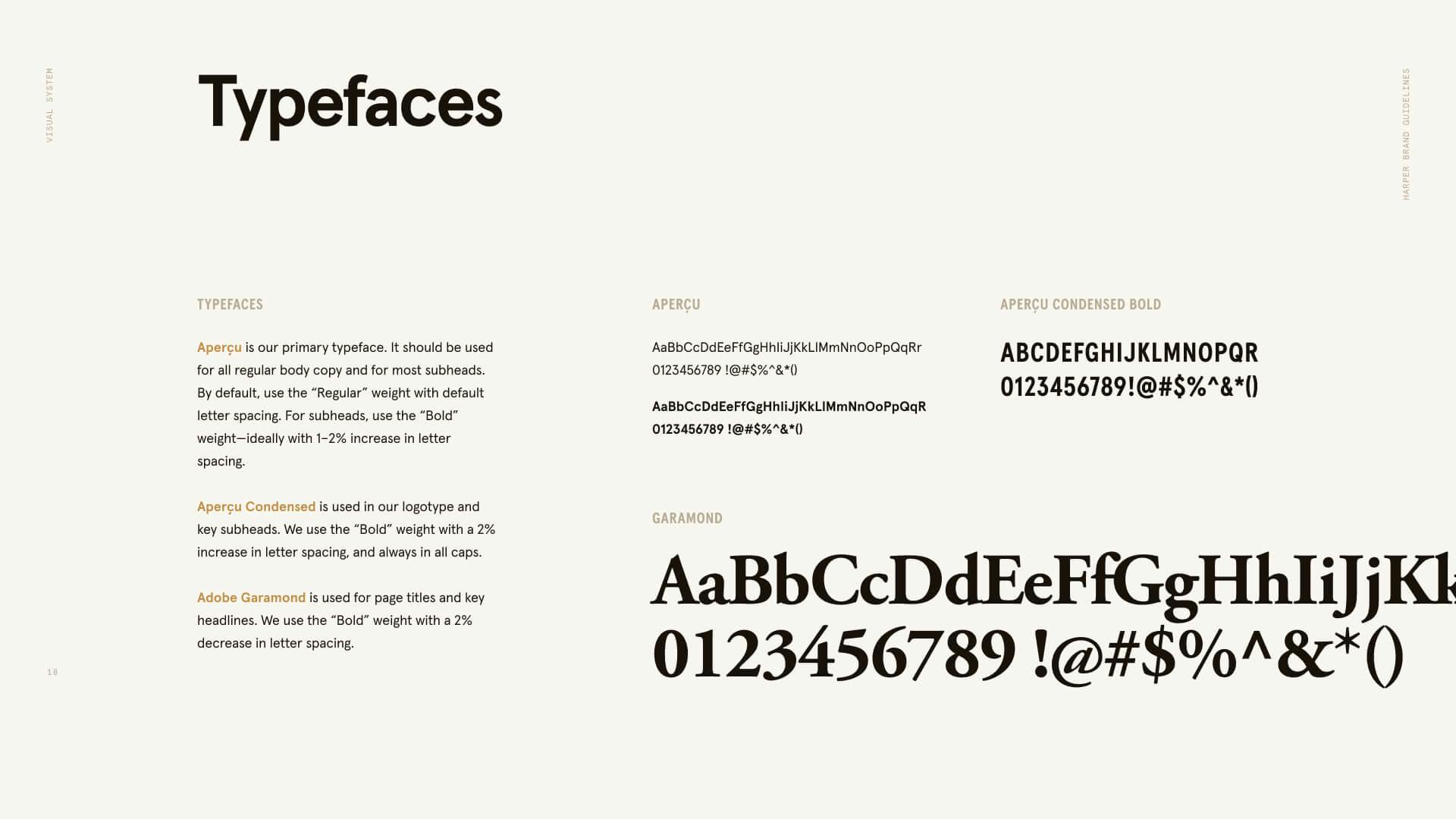
For color, it needed to feel organic to dogs and their environment. No sterile whites, neon greens, or corporate blues.
Instead we used an array of warm tones, beiges, creams, and tans that were all either found directly in dog coats and fur, or from the grass, clay, and sky in their outdoor environment.
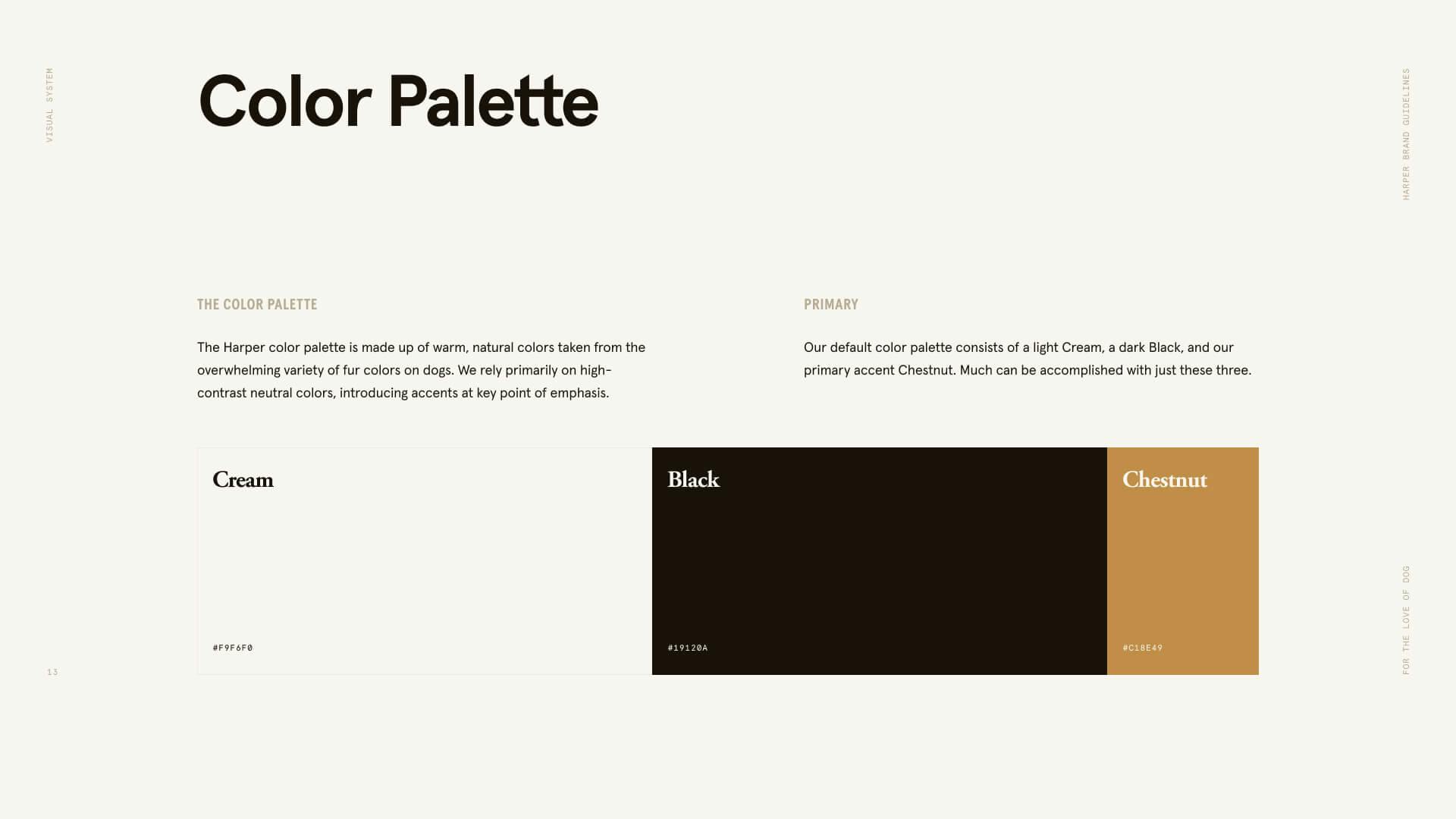
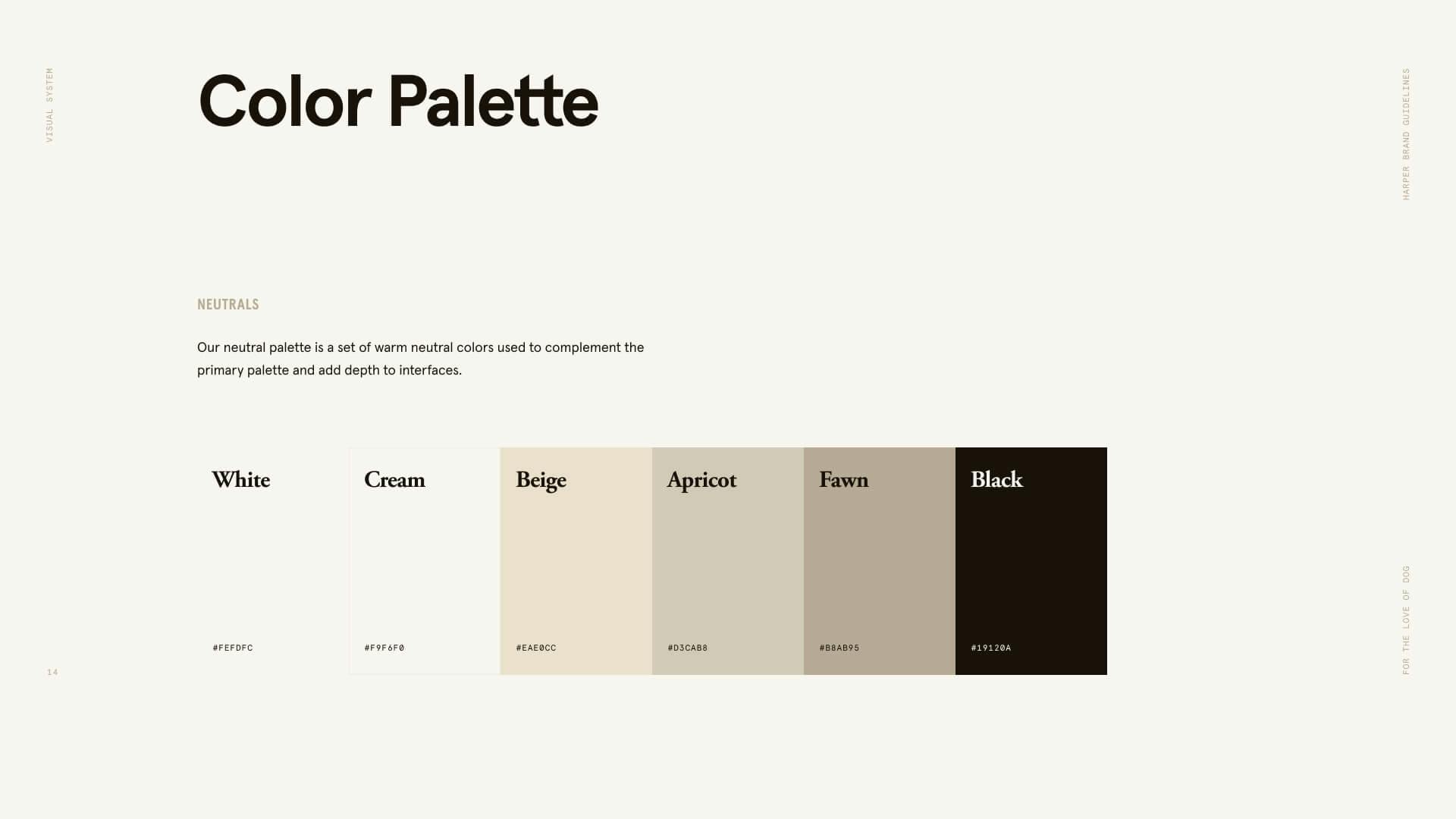
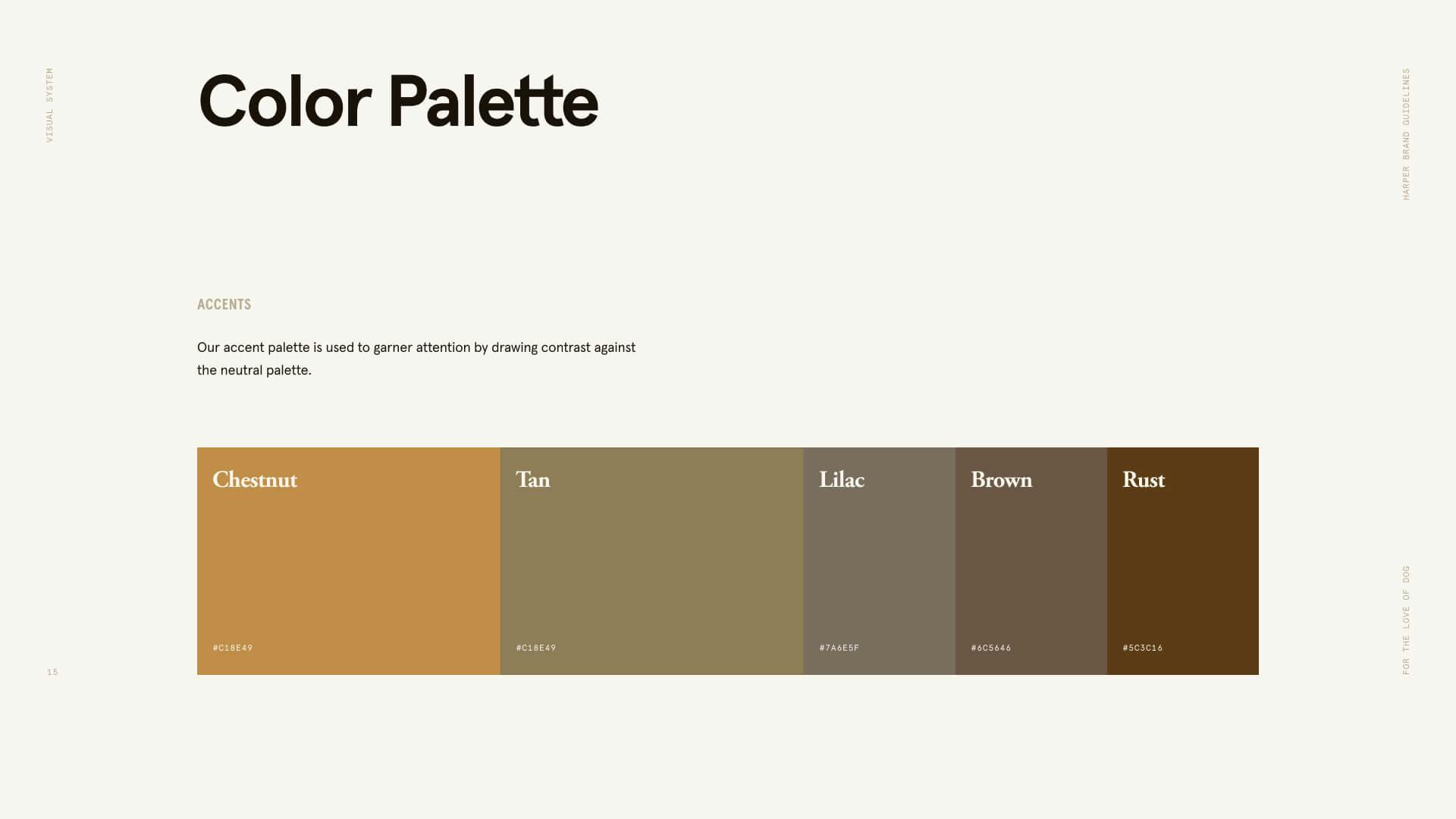
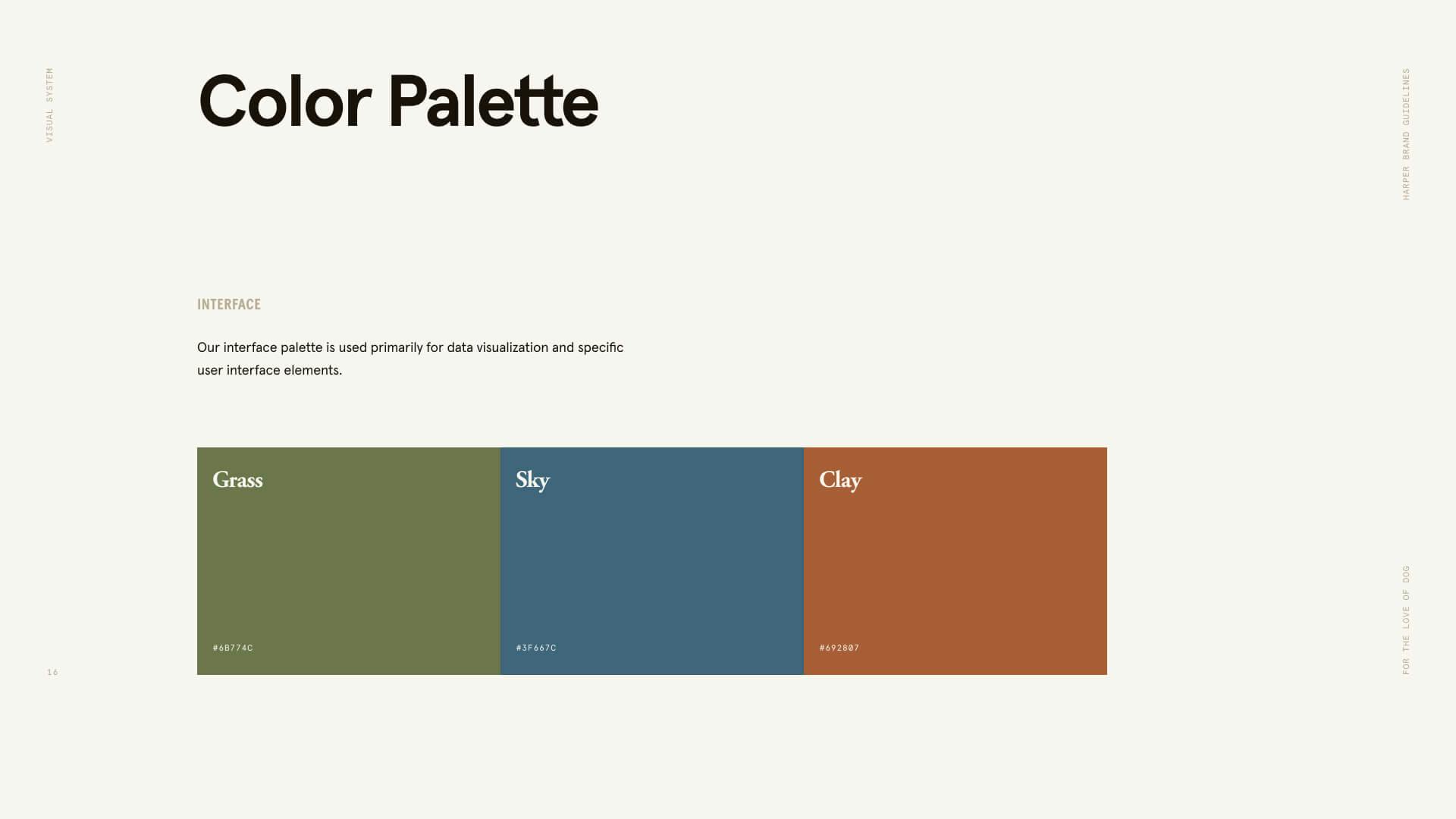
Photography & Style
Lastly, we emphasized photography over illustration.
Illustration is useful for taking something big and complex and making it feel smaller and more approachable.
We had to do the opposite. We needed to take what felt like small banal stuff and breathe meaning into it.
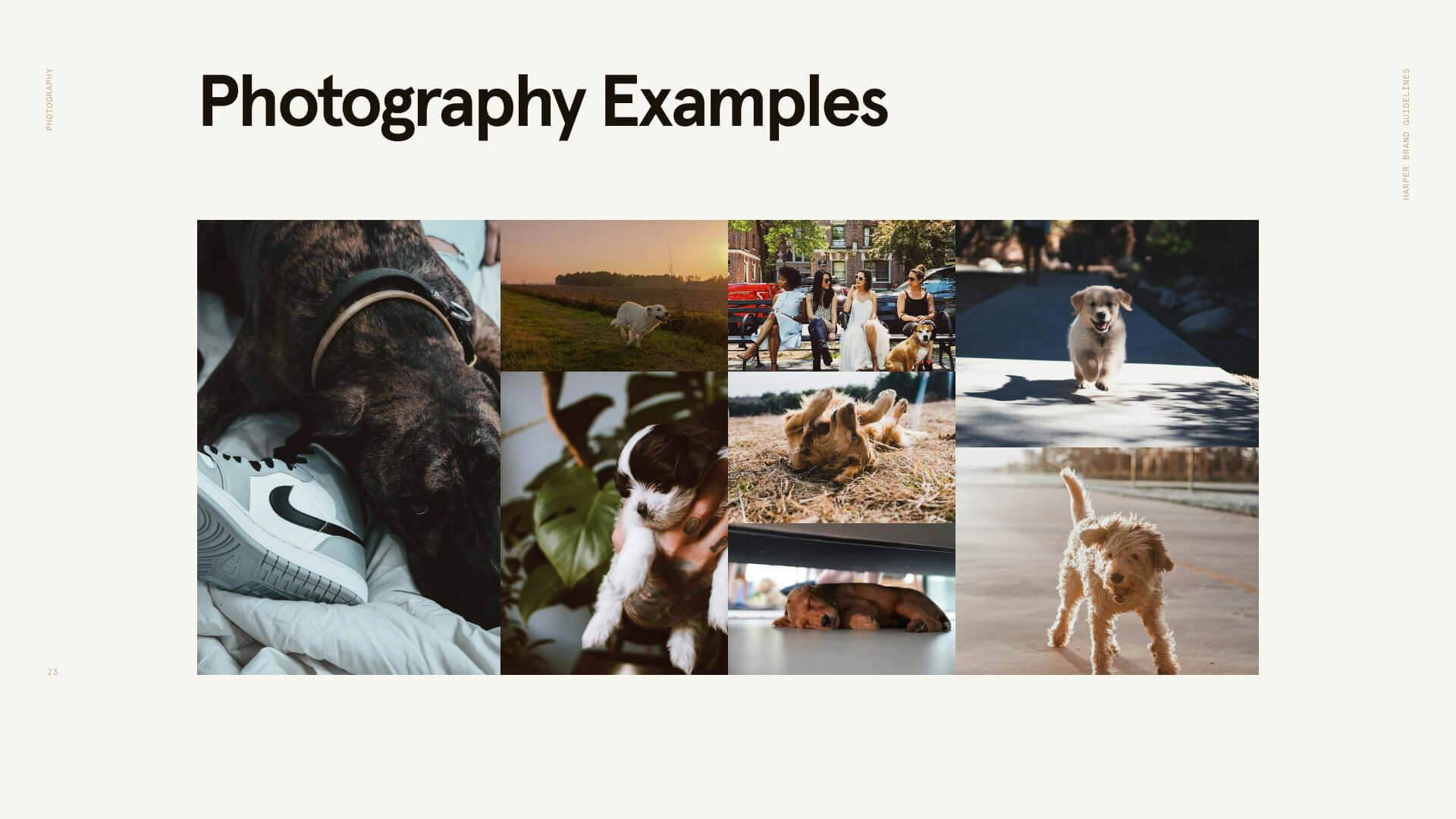
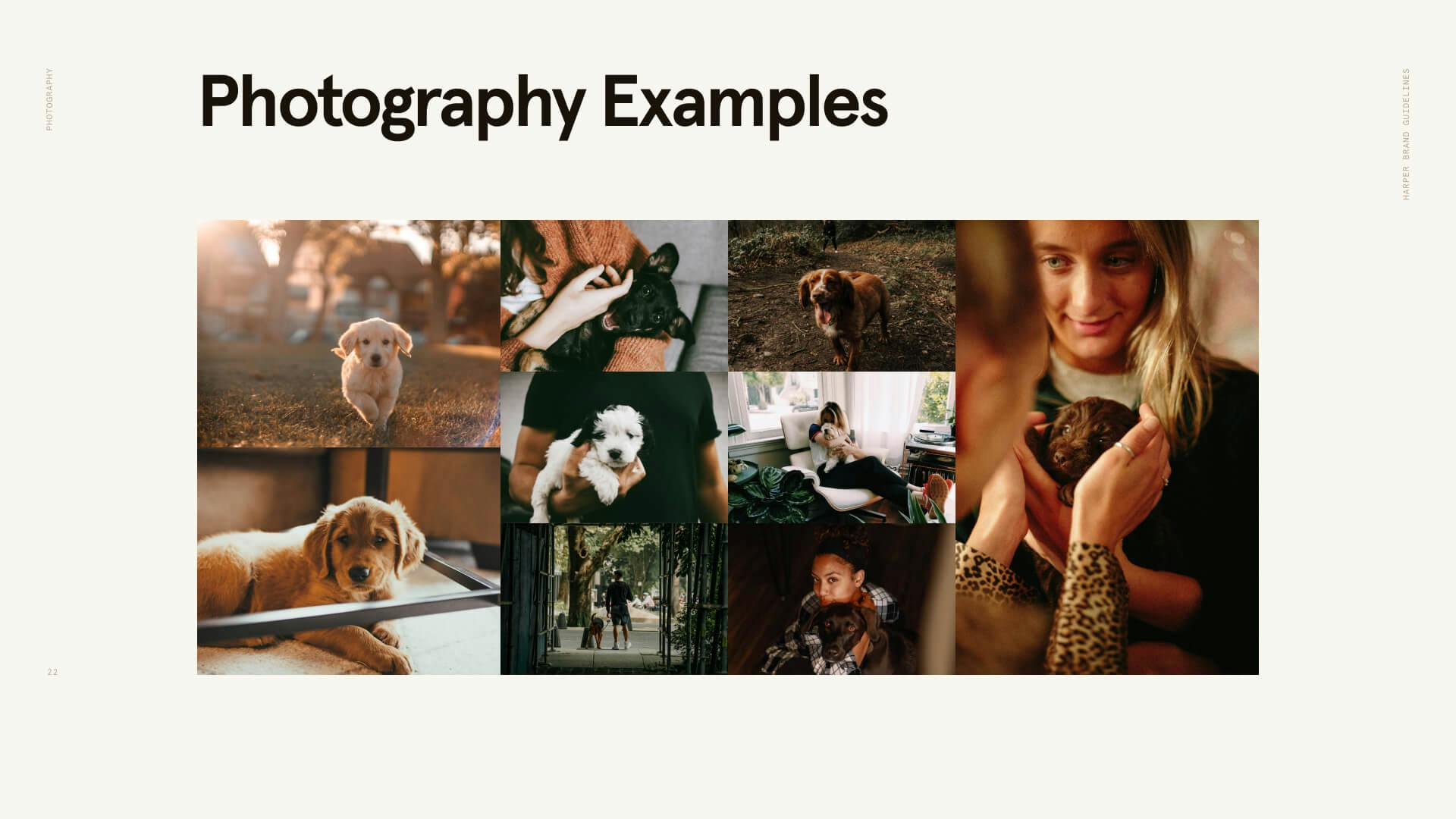
We relied on lifestyle photography that showed the ideal state we aspire to with our dogs.
We didn’t use anything that felt posed or staged, seldom showed dogs behaving in undesirable ways, and never showed dogs being treated poorly.
And ideally our photography highlighted the golden hours in the morning and evening because those are the primary parts of day when most of us are able to spend real time with our dogs.
I was always looking for warm golden light, rich tones, and an editorial feel.
Results
We didn’t figure it out in time
We initially bootstrapped our way to App Store App of the Day, an invitation to the Purina Pet Care Innovation Network, and a few thousand in recurring revenue.
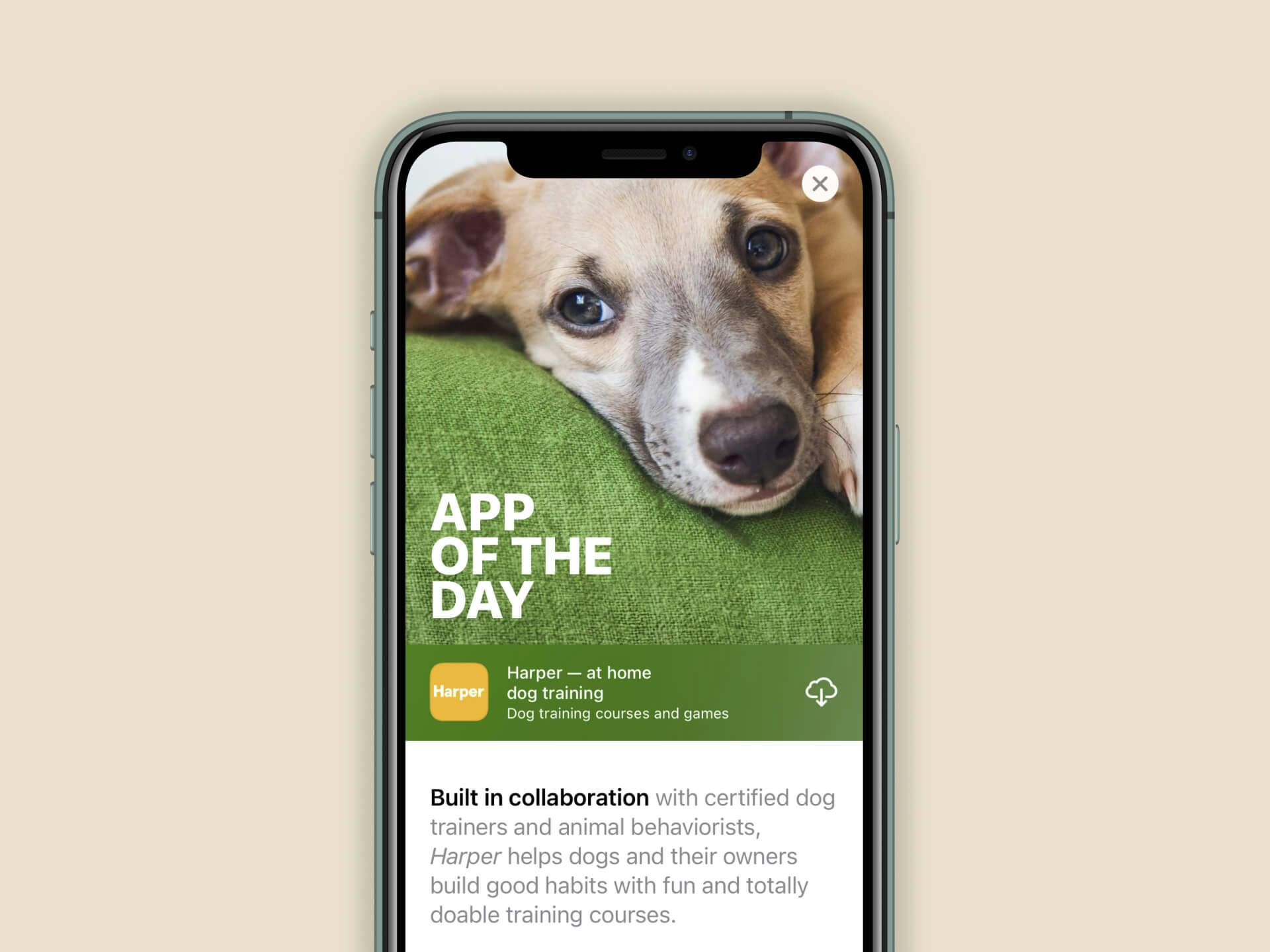
We were able to parlay that into a pre-seed round from M25, Shrug, and a few others.
But I began to realize what we built would soon plateau at a local maxima. It was helping dog owners, but under the surface, the metrics showed we weren’t going to grow fast or efficiently enough.
We spent the remaining time interviewing dog owners, building, measuring analytics, and iterating on the app. A lot.
Ultimately, we never solved the puzzle in time. We fell prey to the fatal pinch.
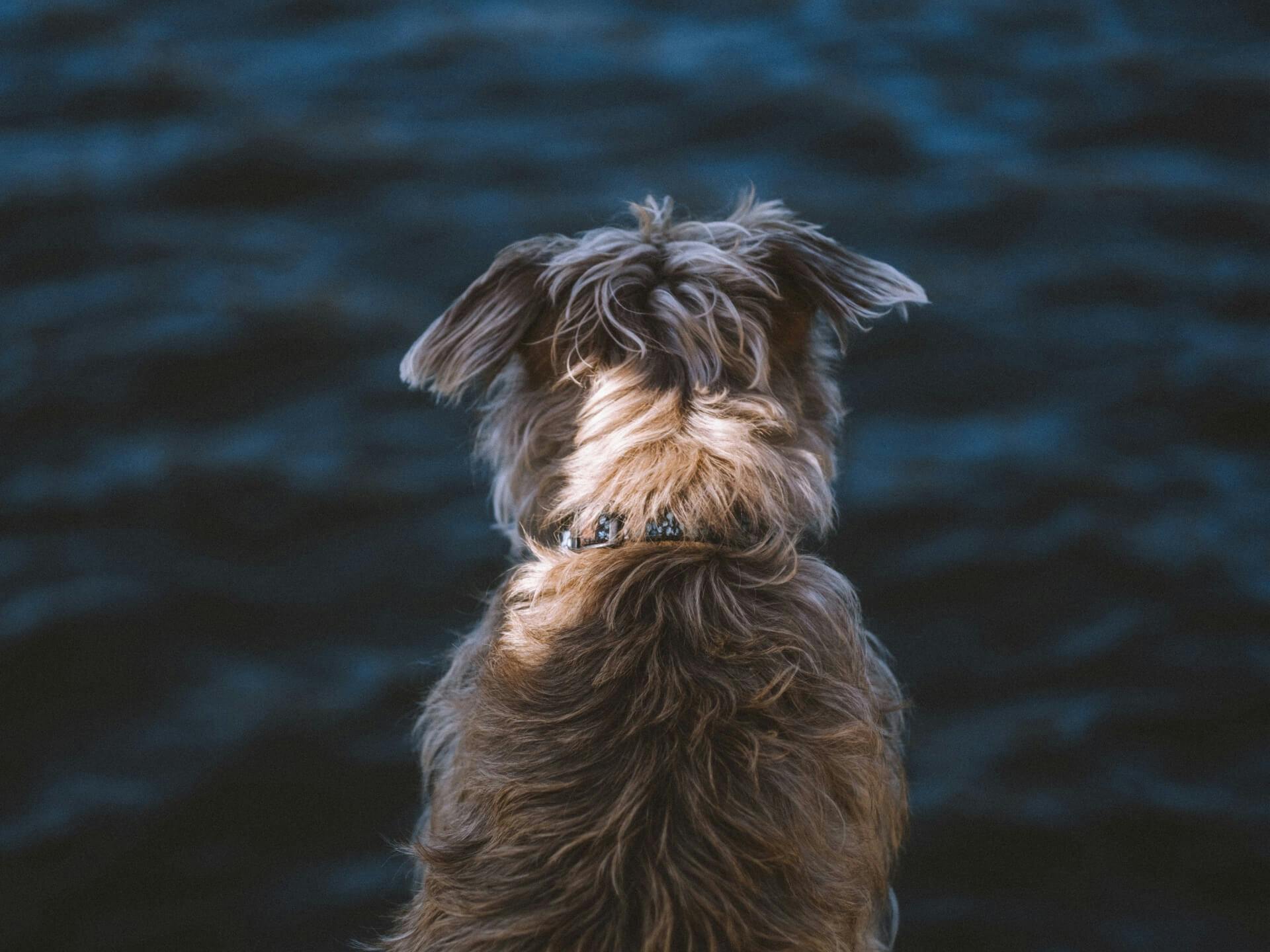
We made a few poor decisions. Among the startup sins I committed, the most egregious was building a product caught in a market dead zone.
Harper wasn’t valuable enough as single-player utility to be a high gross margin training solution. I’m pretty certain that’s not a venture-scale business, but it is one that can generate cash.
The app also wasn’t light and multi-player enough to be a vertical social play (like a Strava or Supergreat) that created value and monetized through network effects amongst all dog owners.
Instead, we were caught in a kind of product uncanny valley without enough gas in the tank for another iteration.
At the end of 2023 we kicked back the remaining capital to our investors and sunset the project.